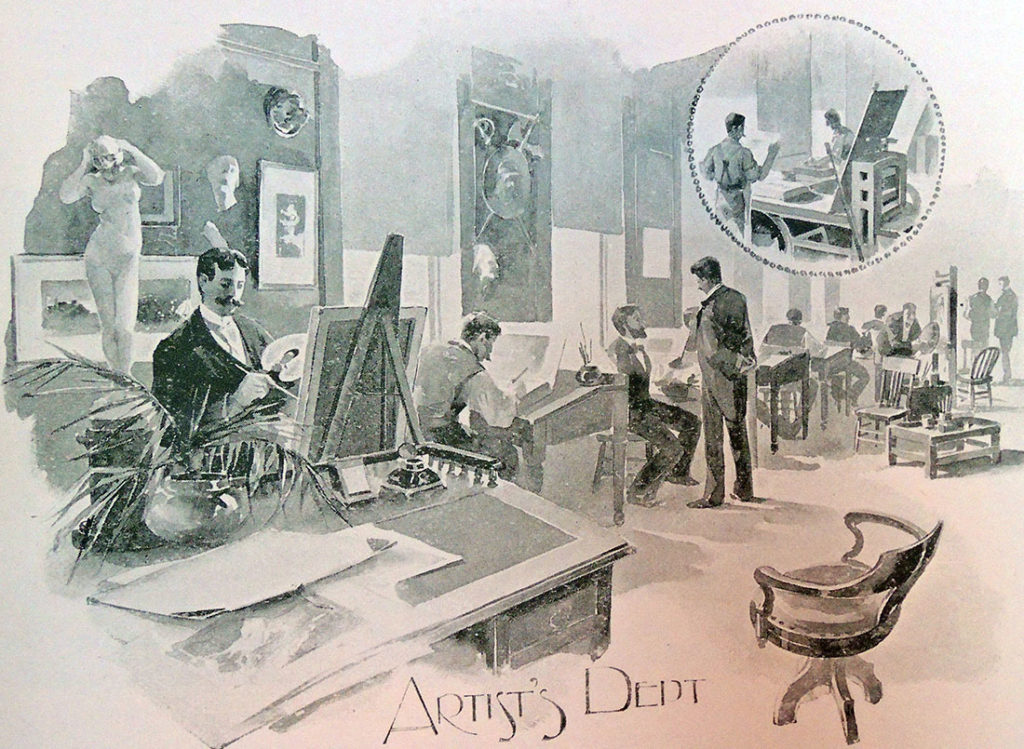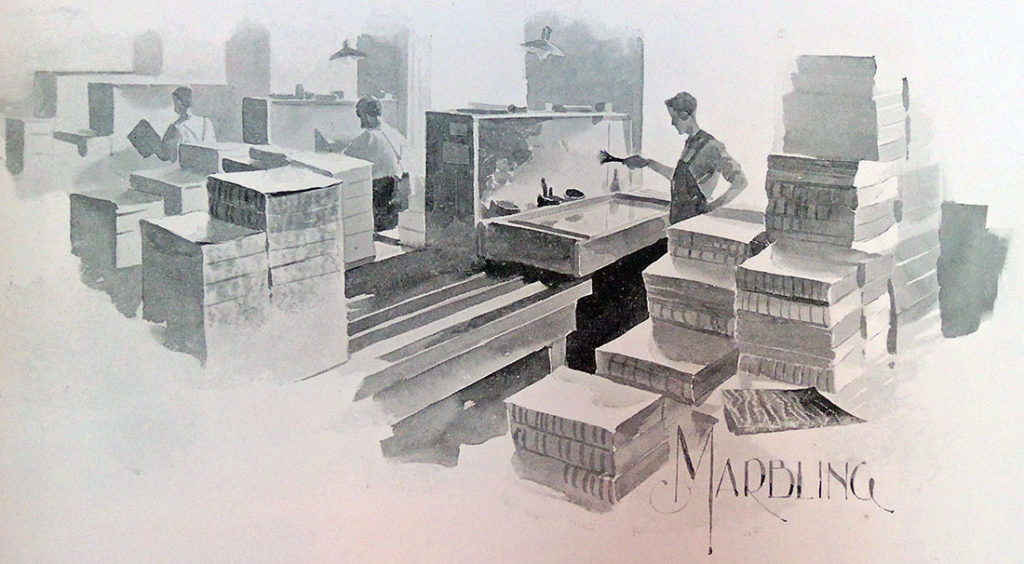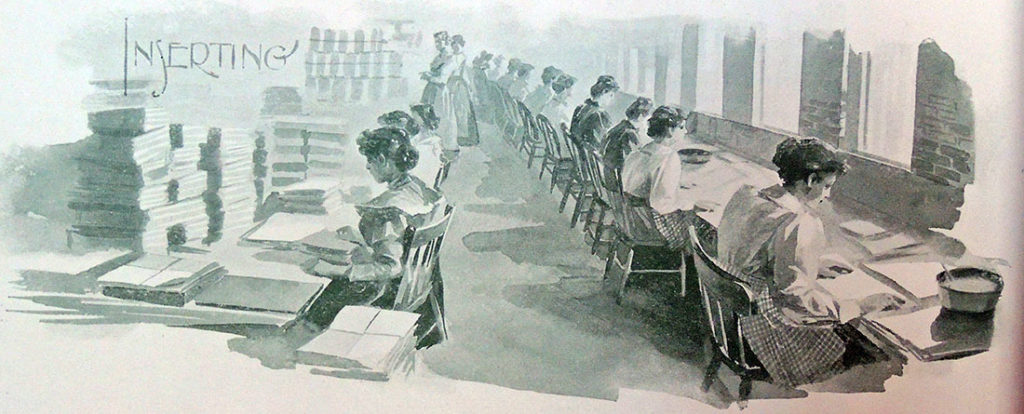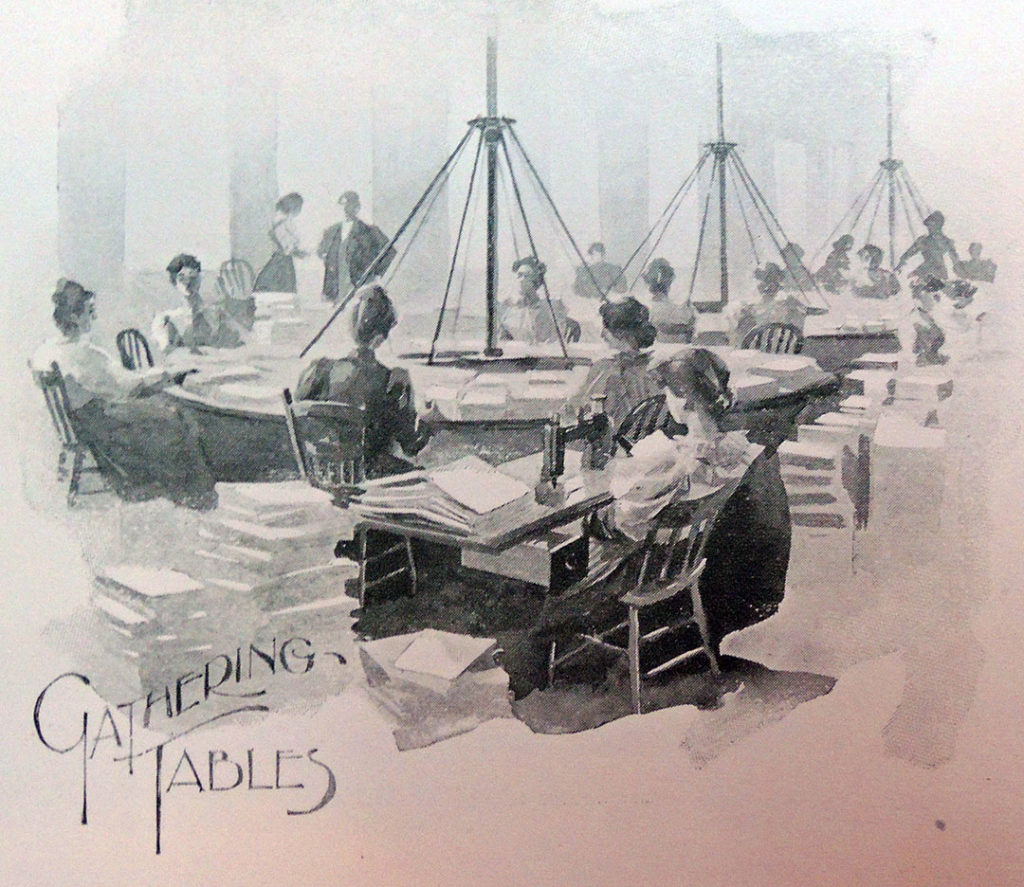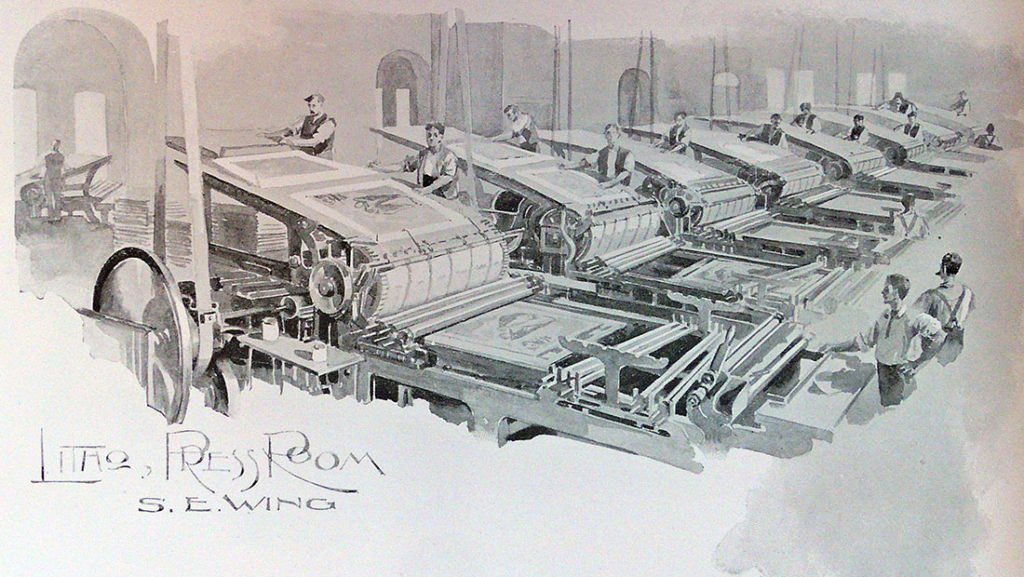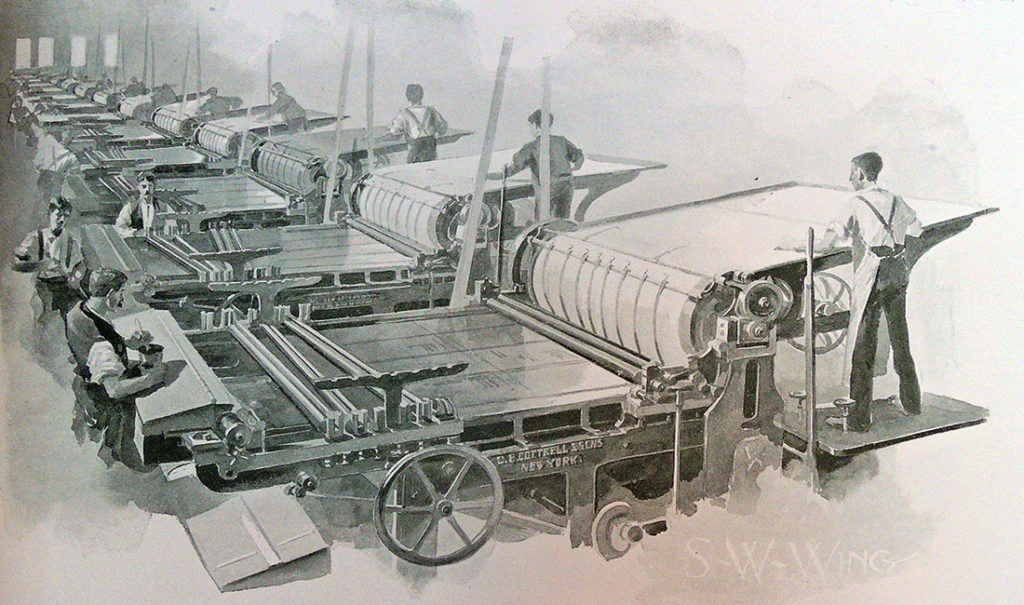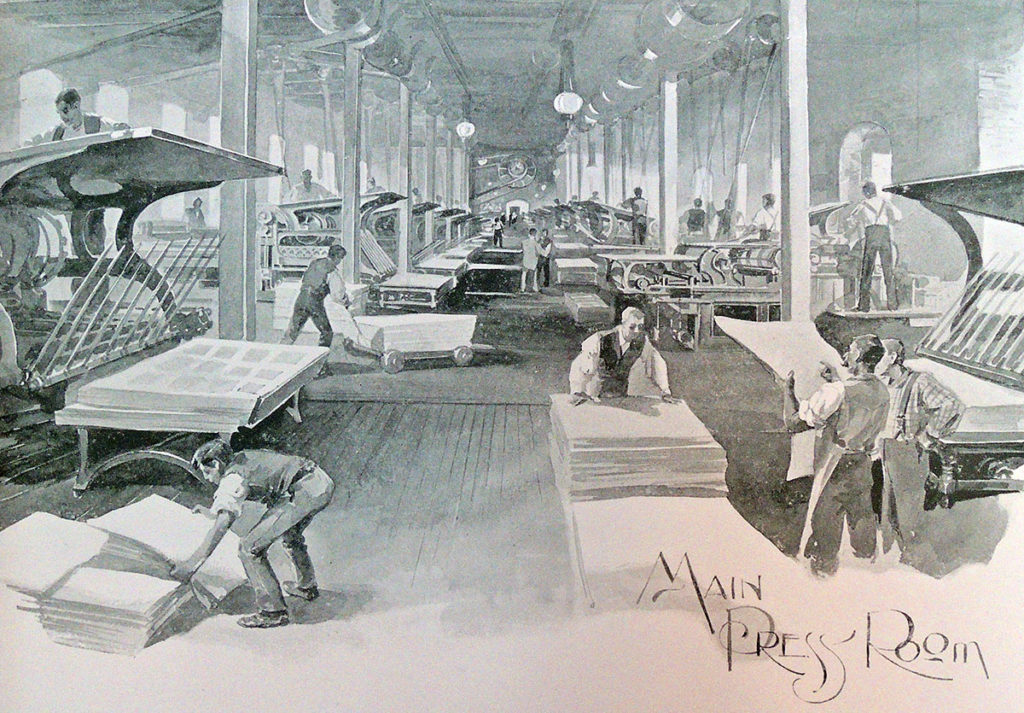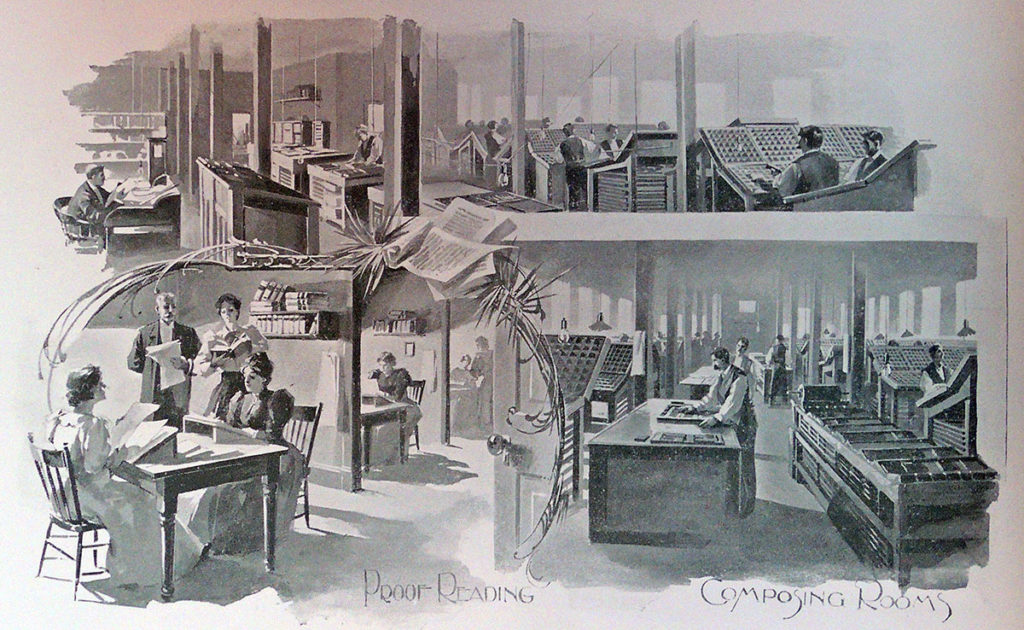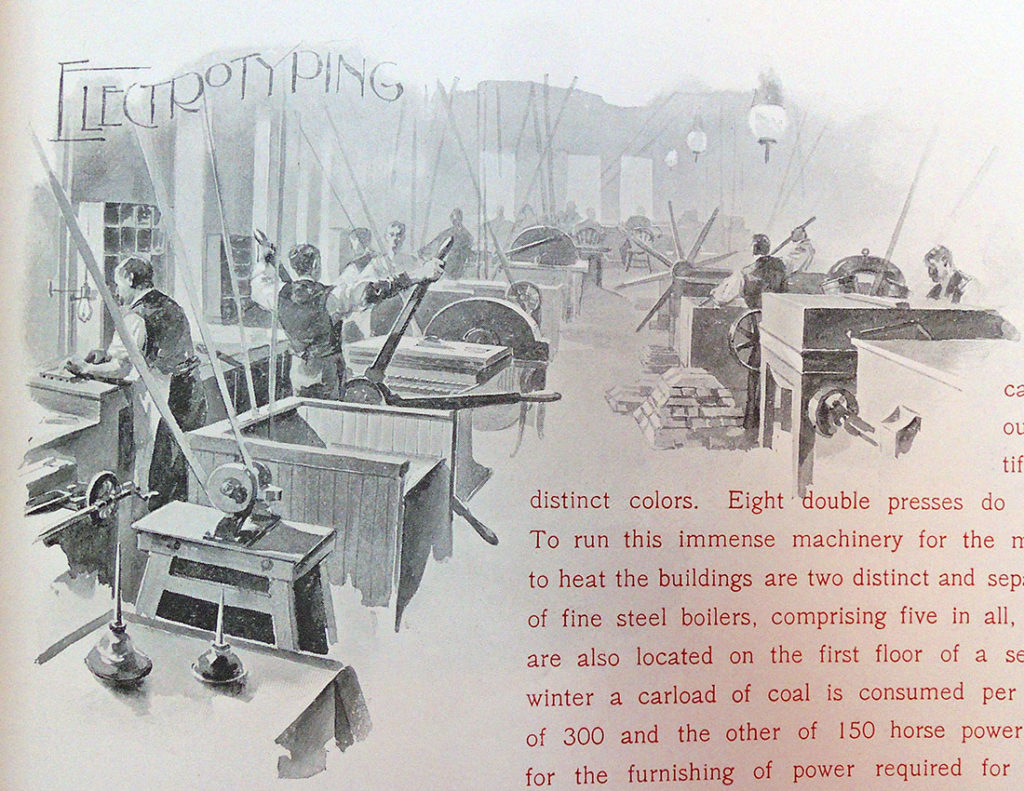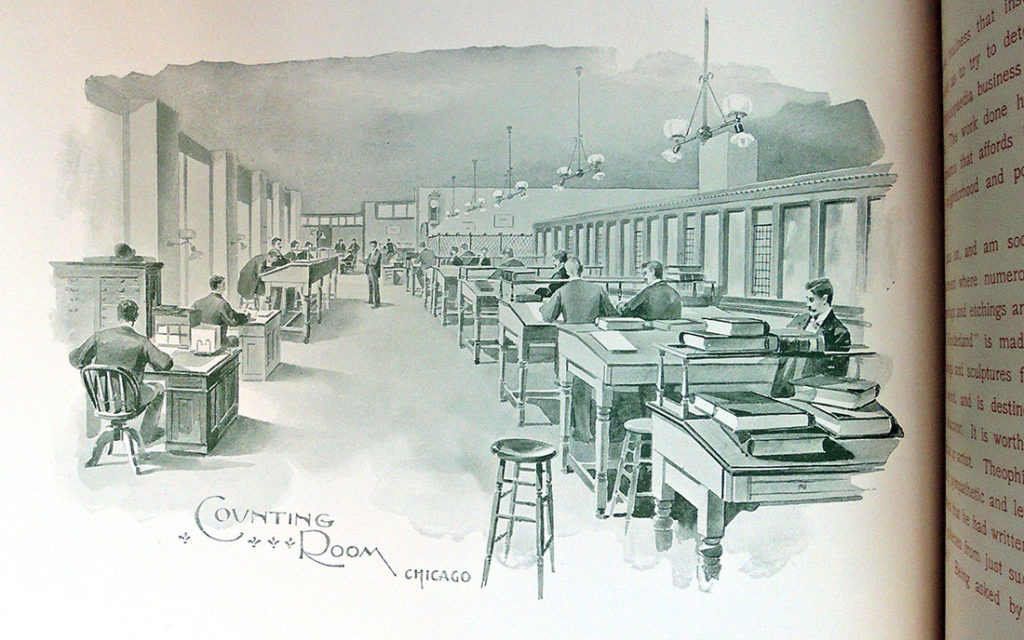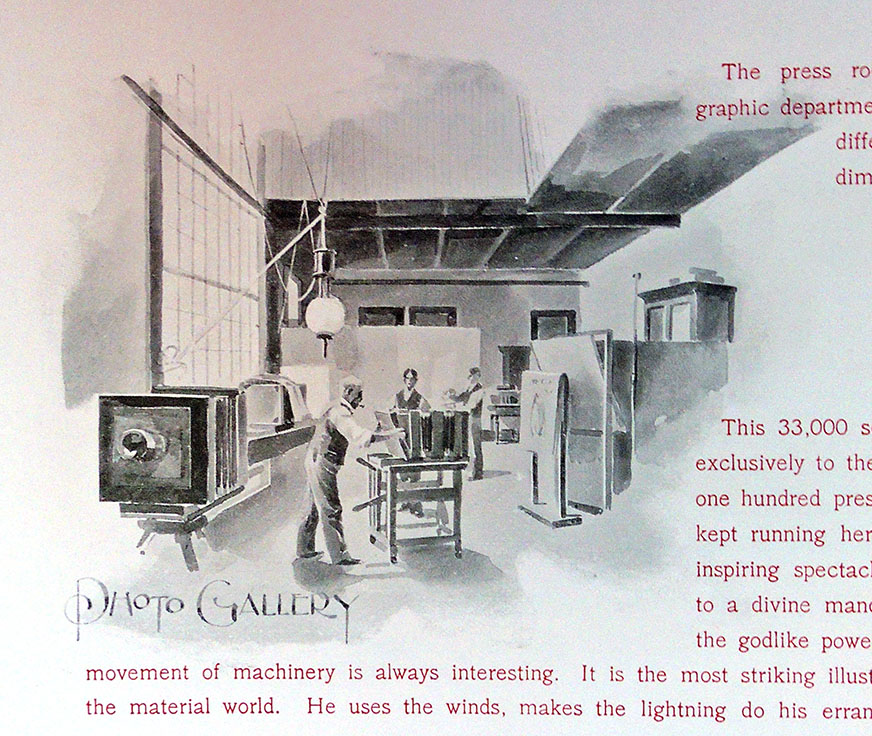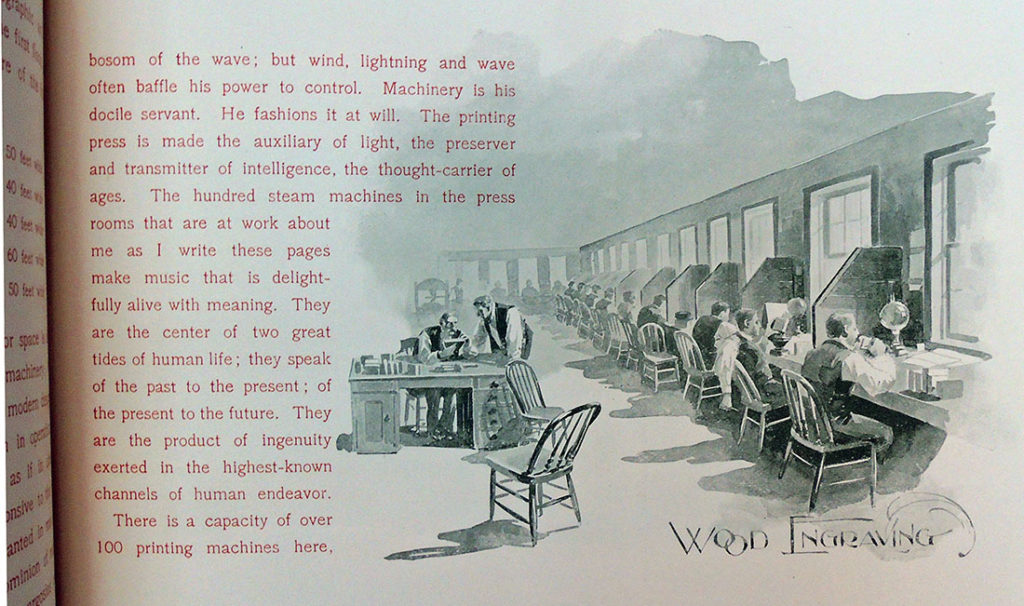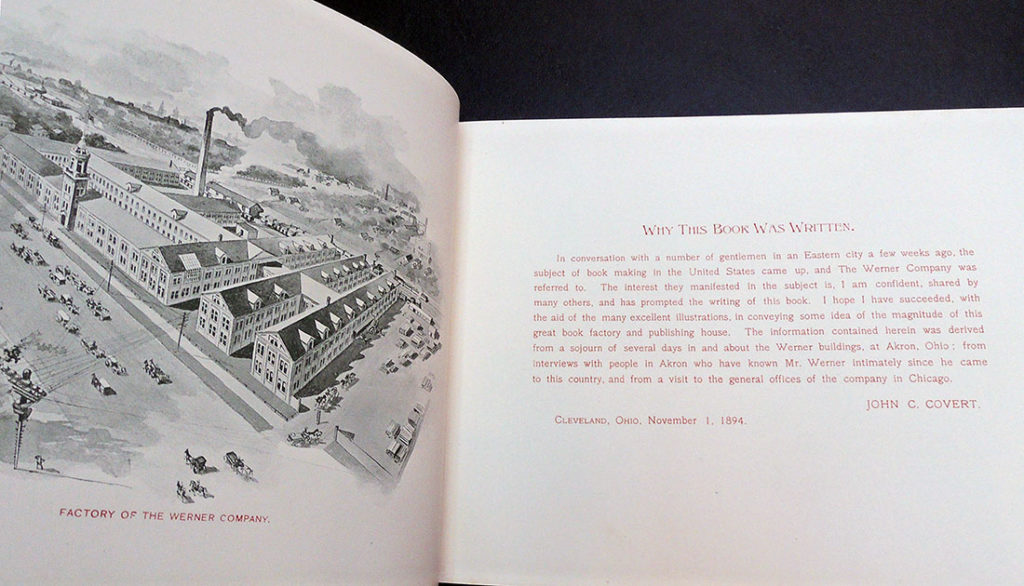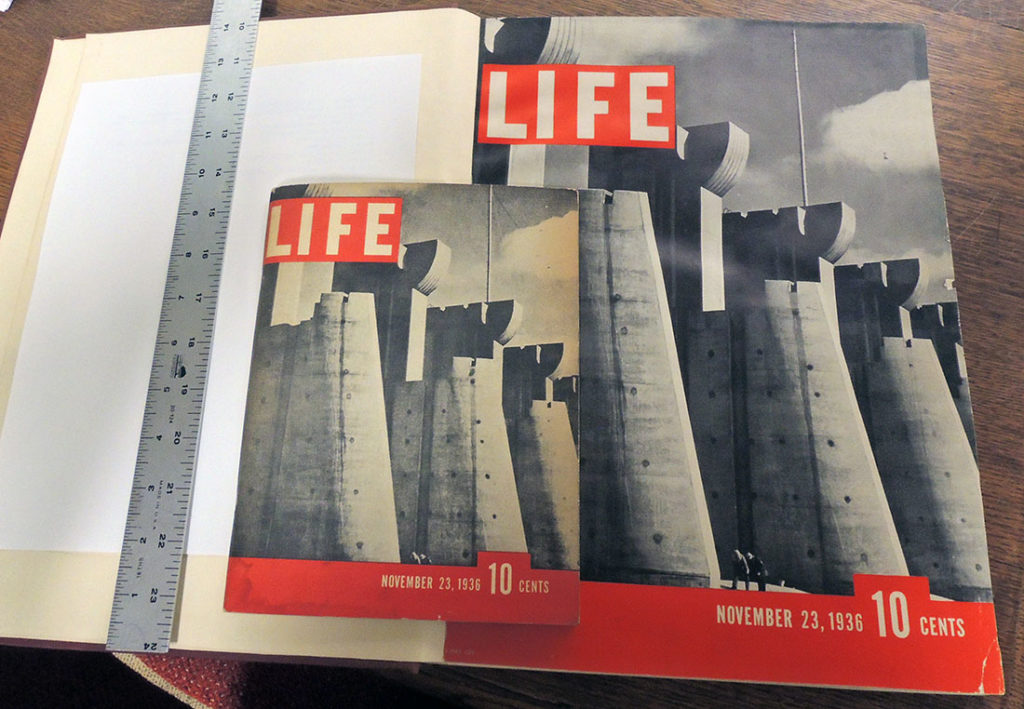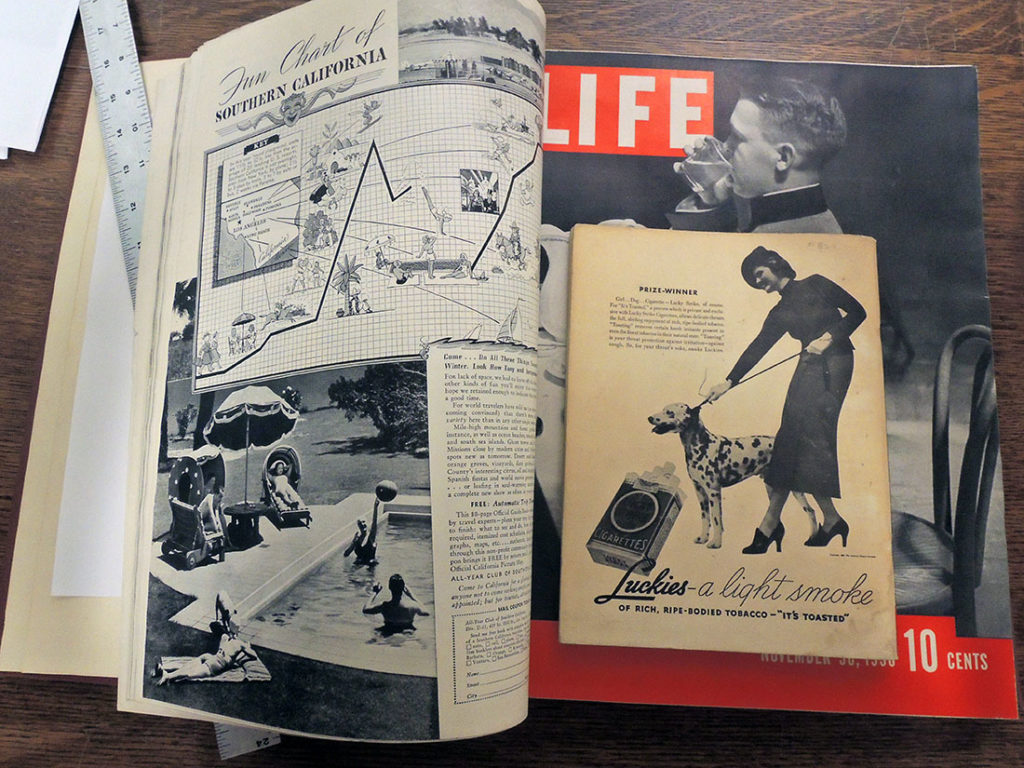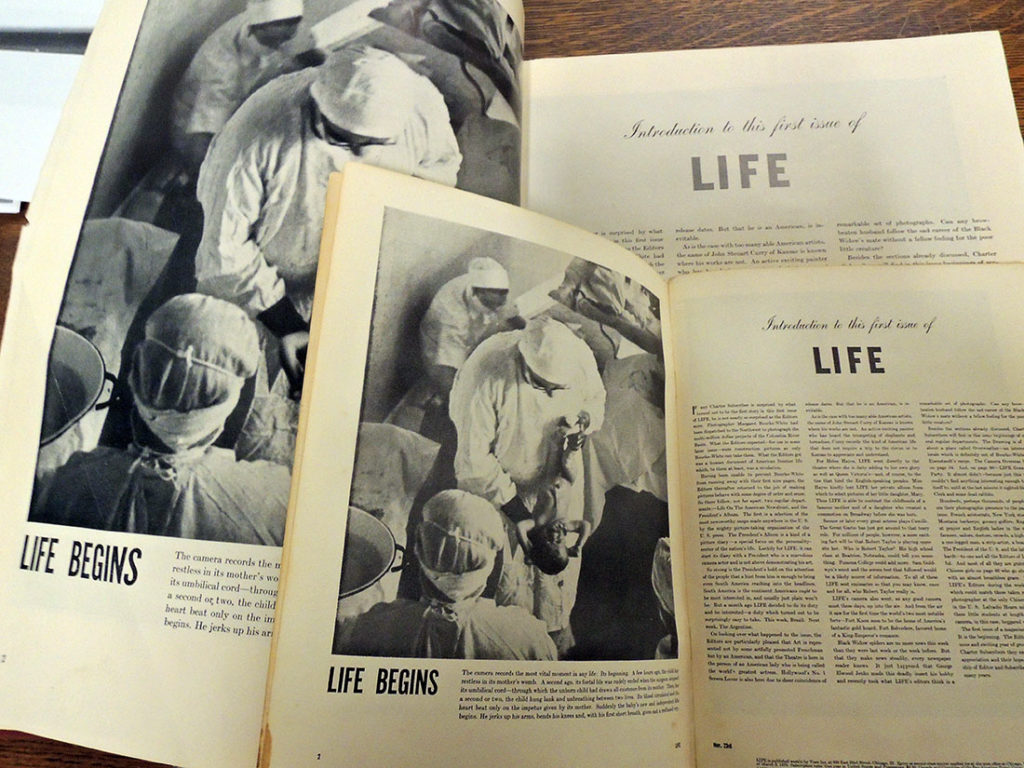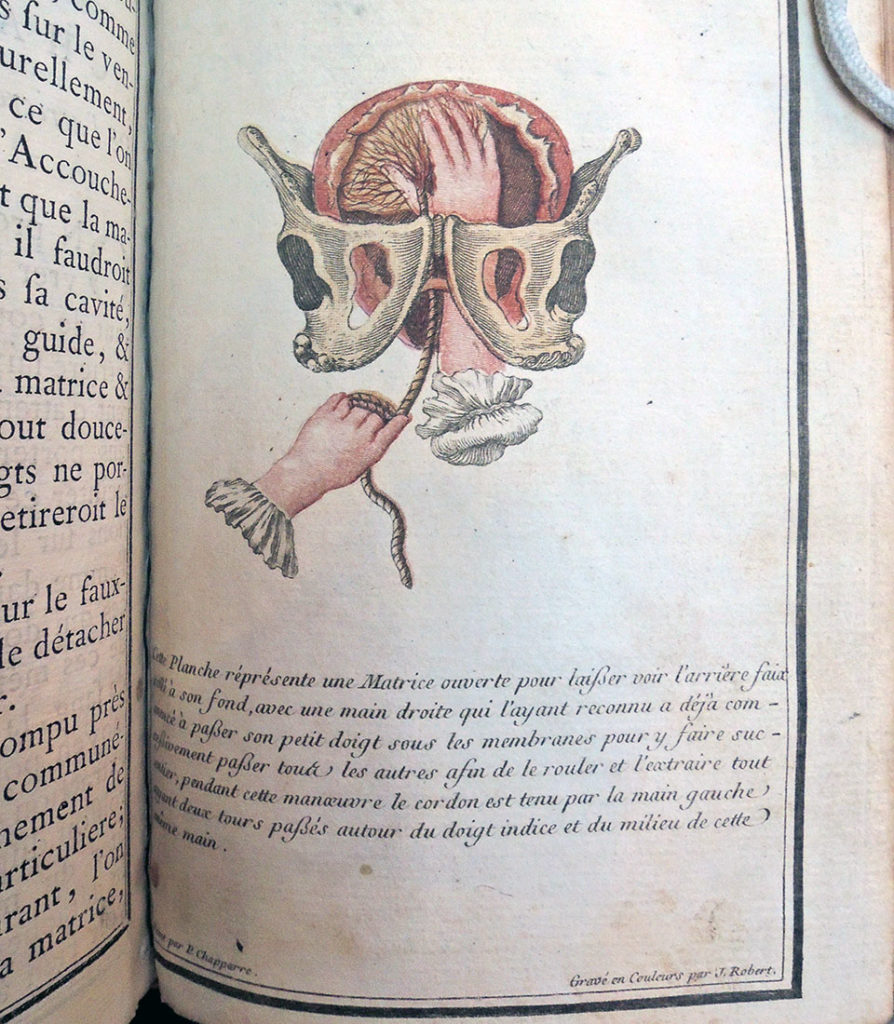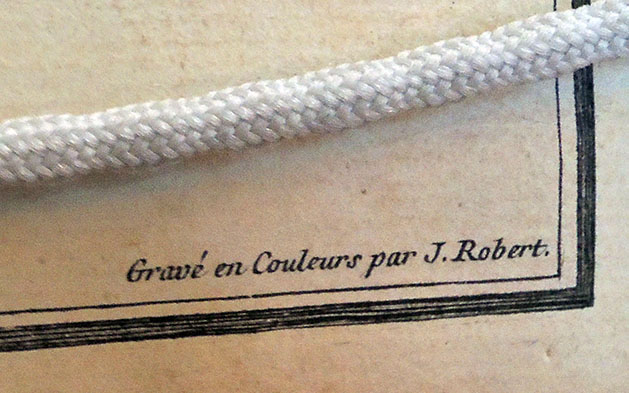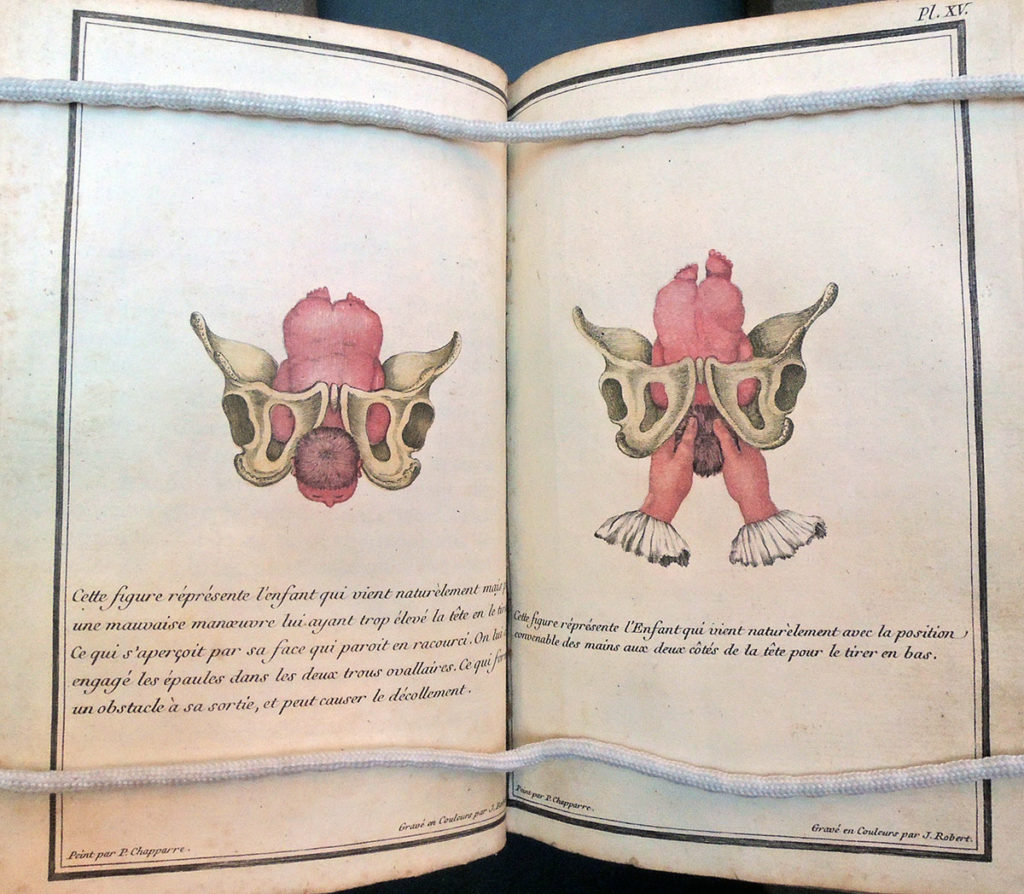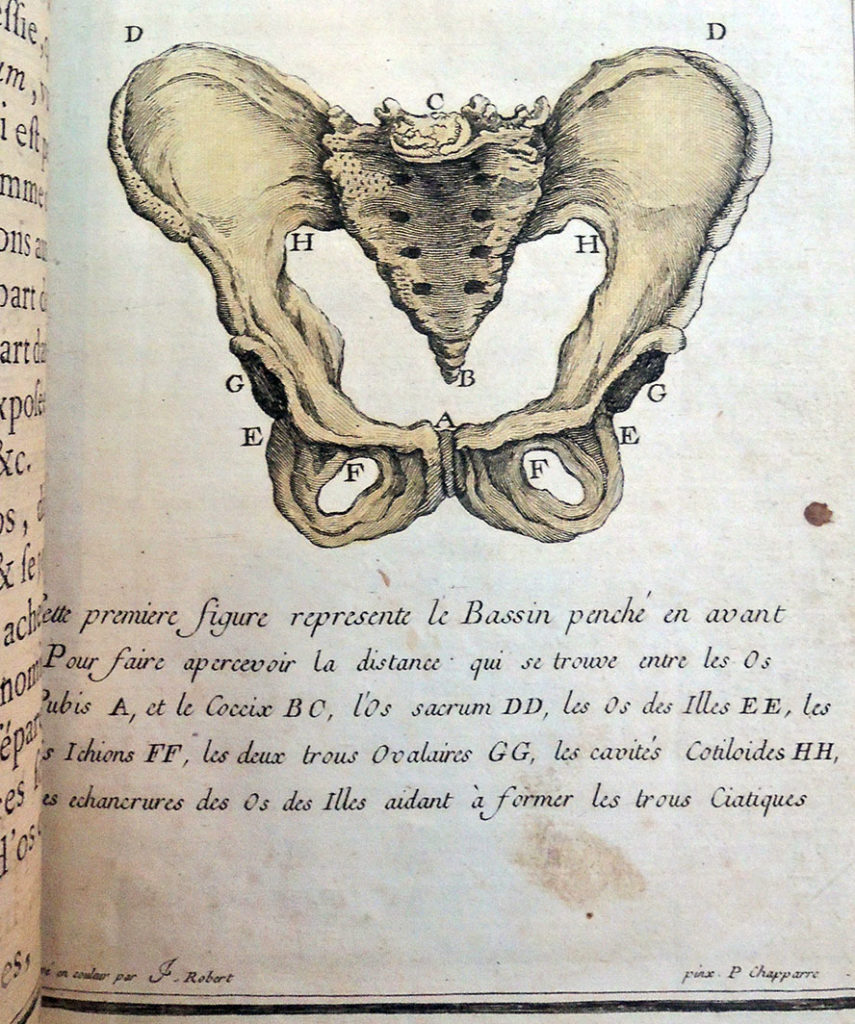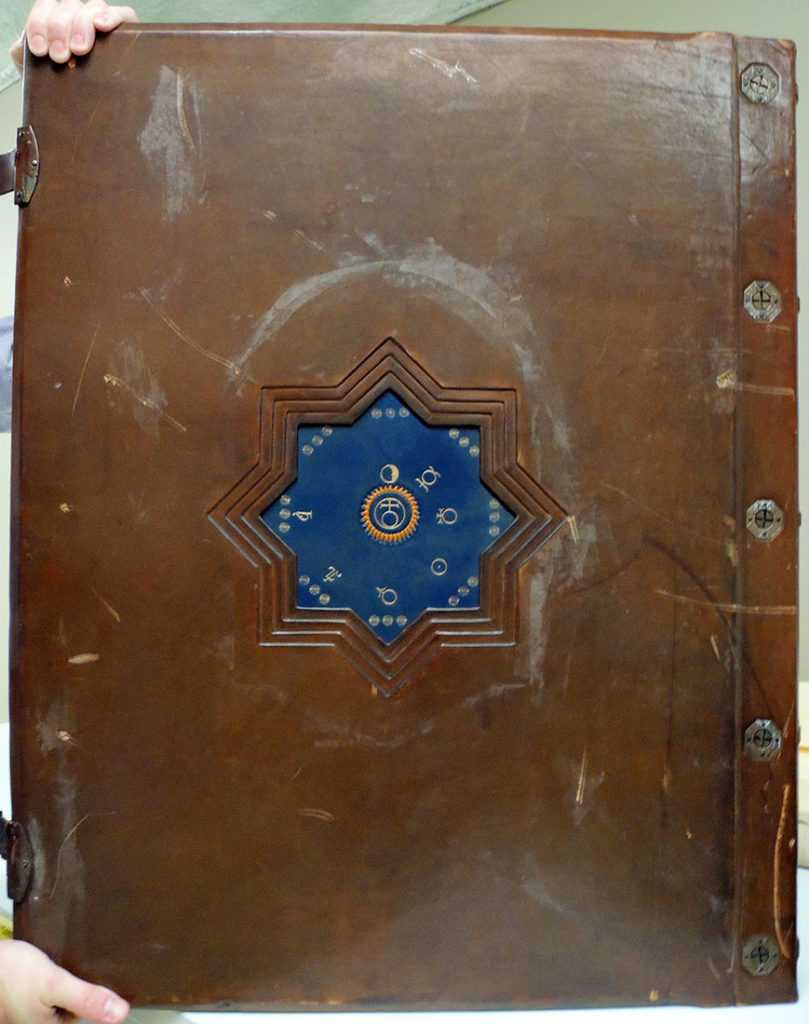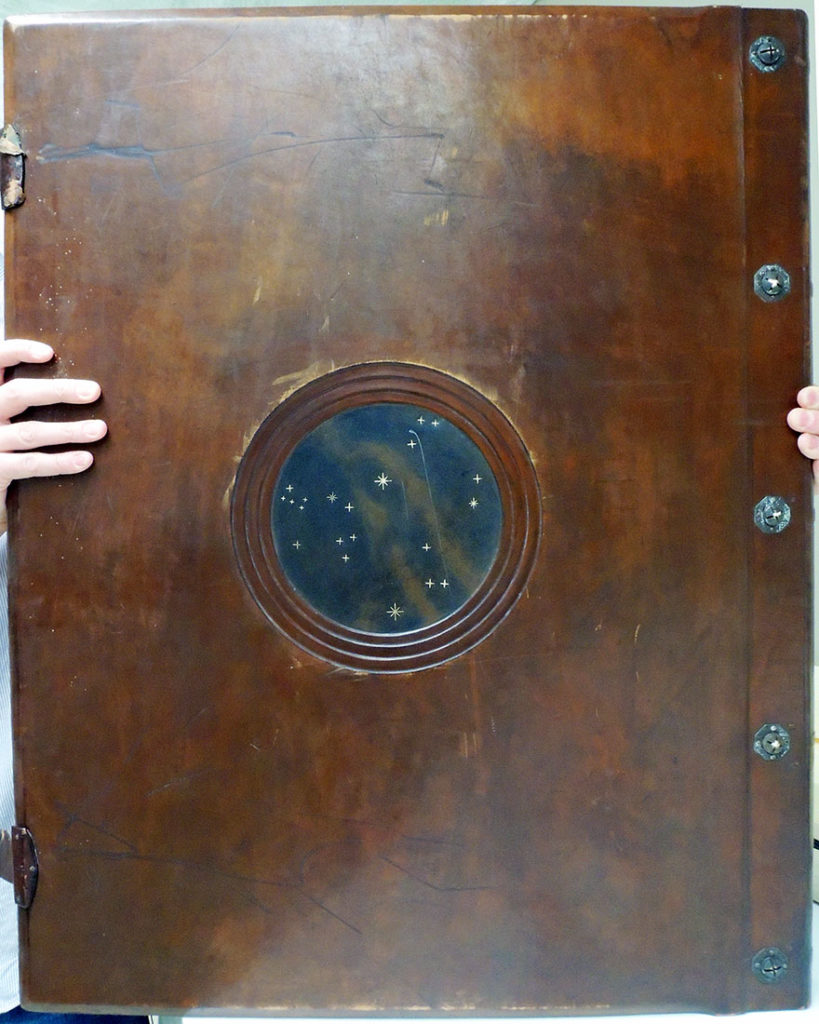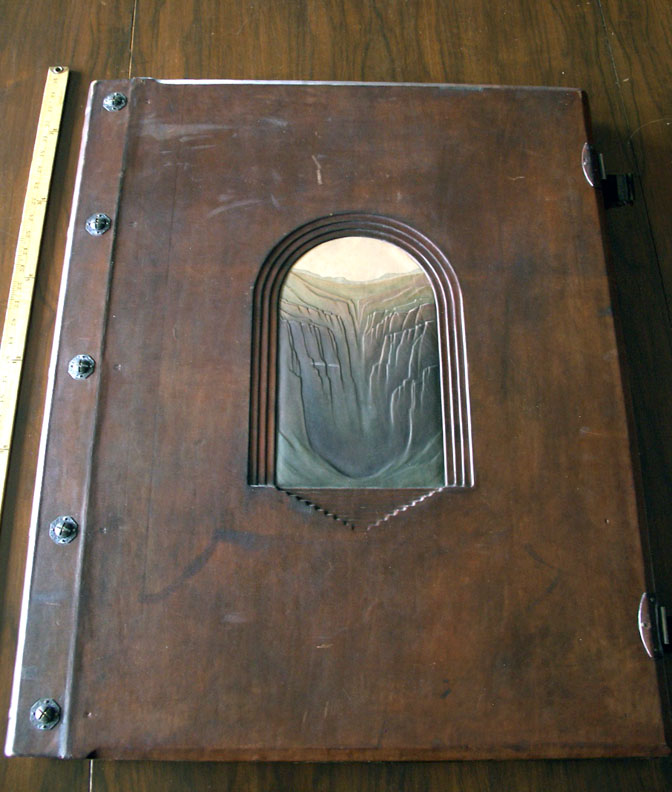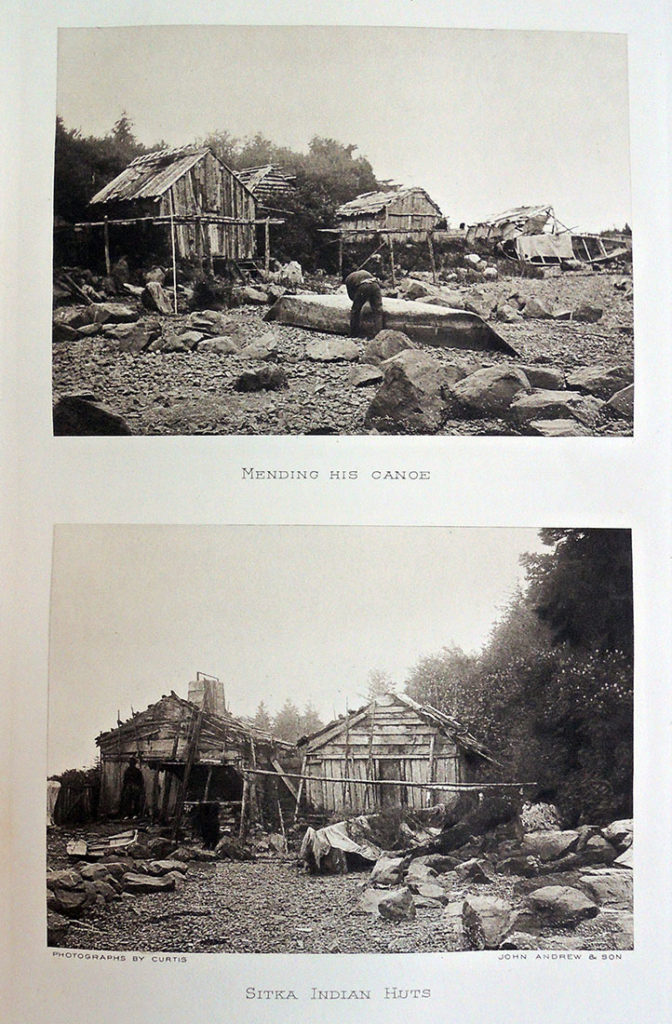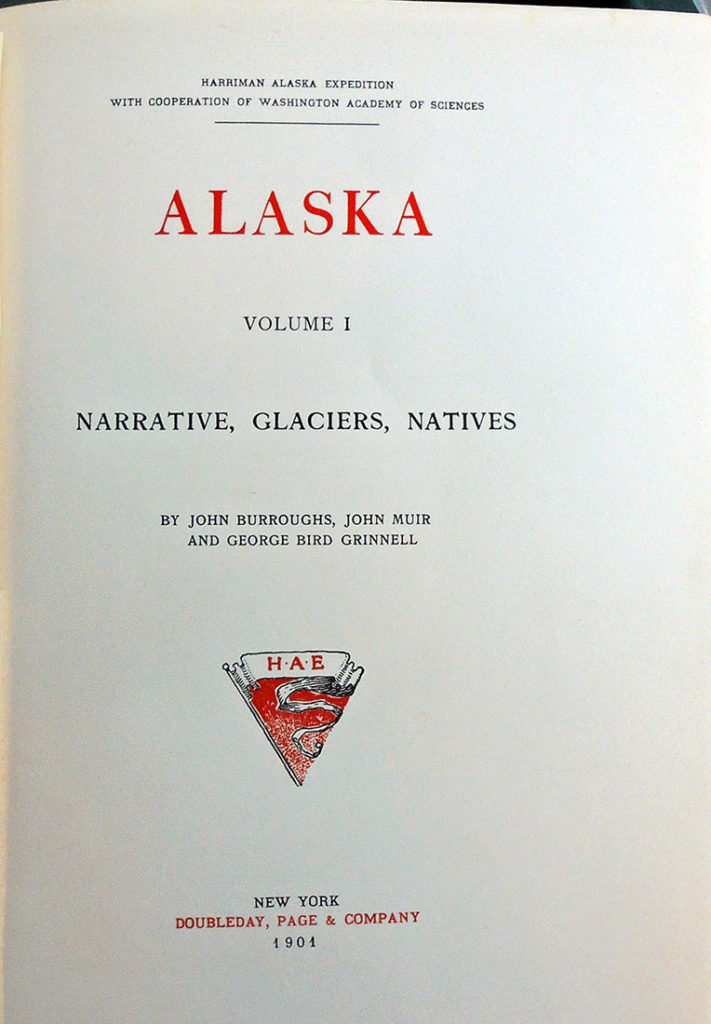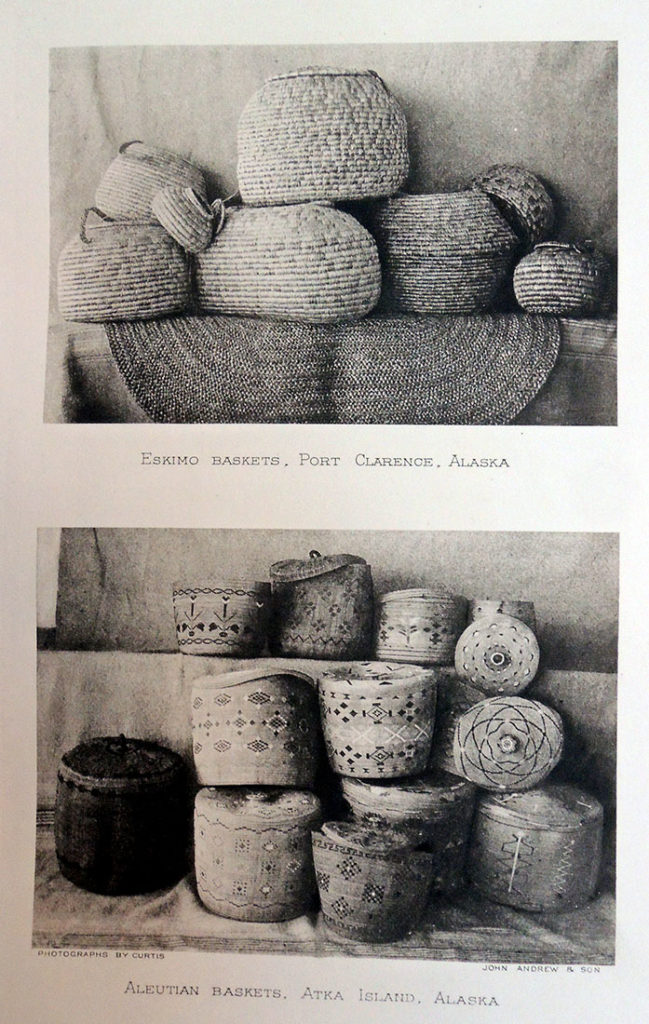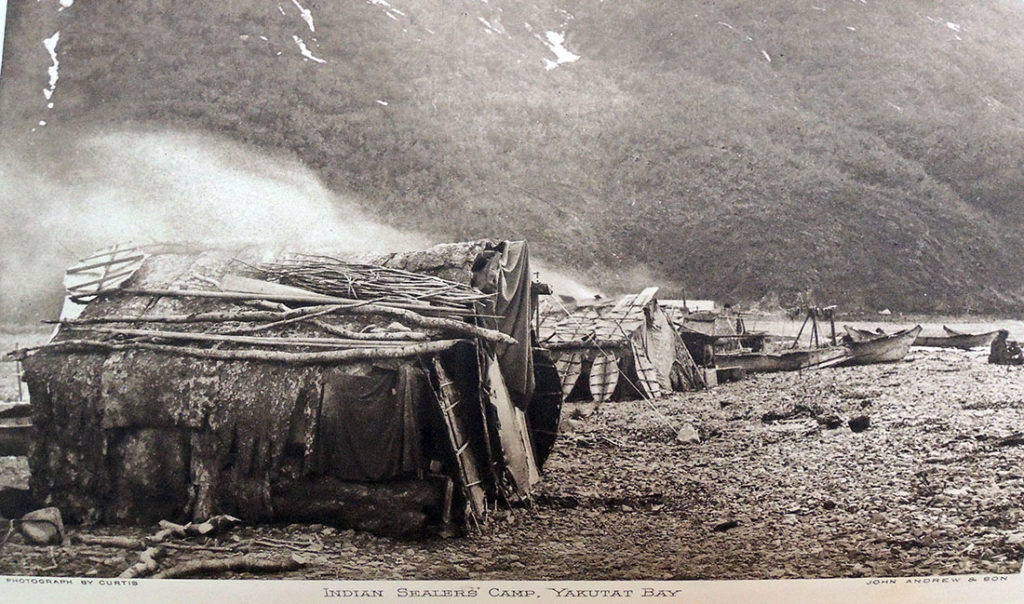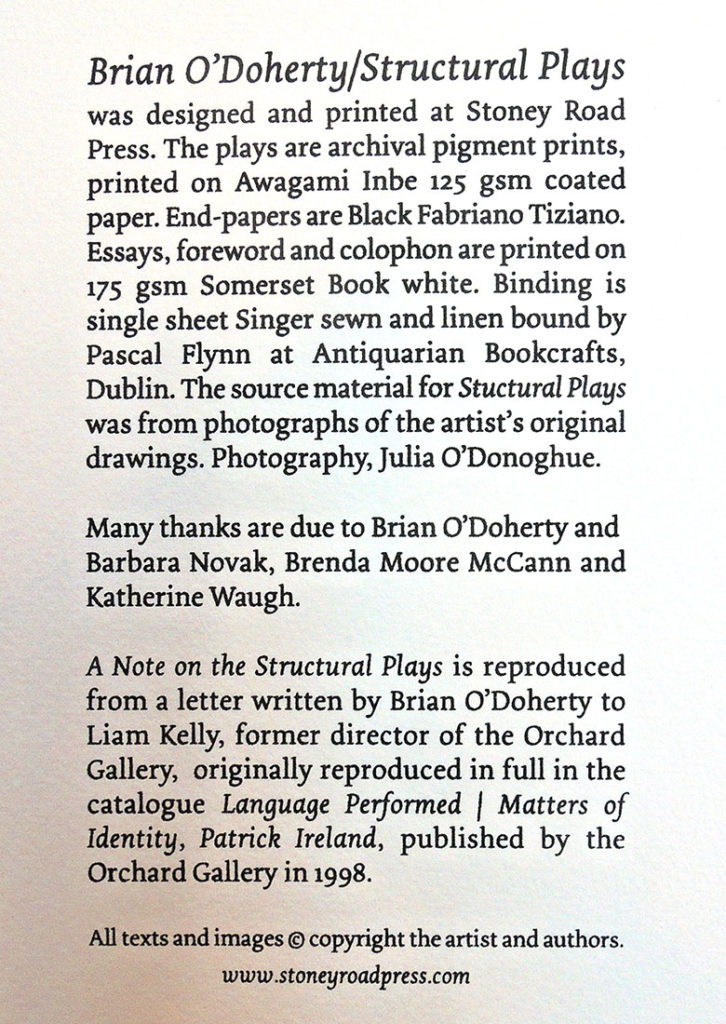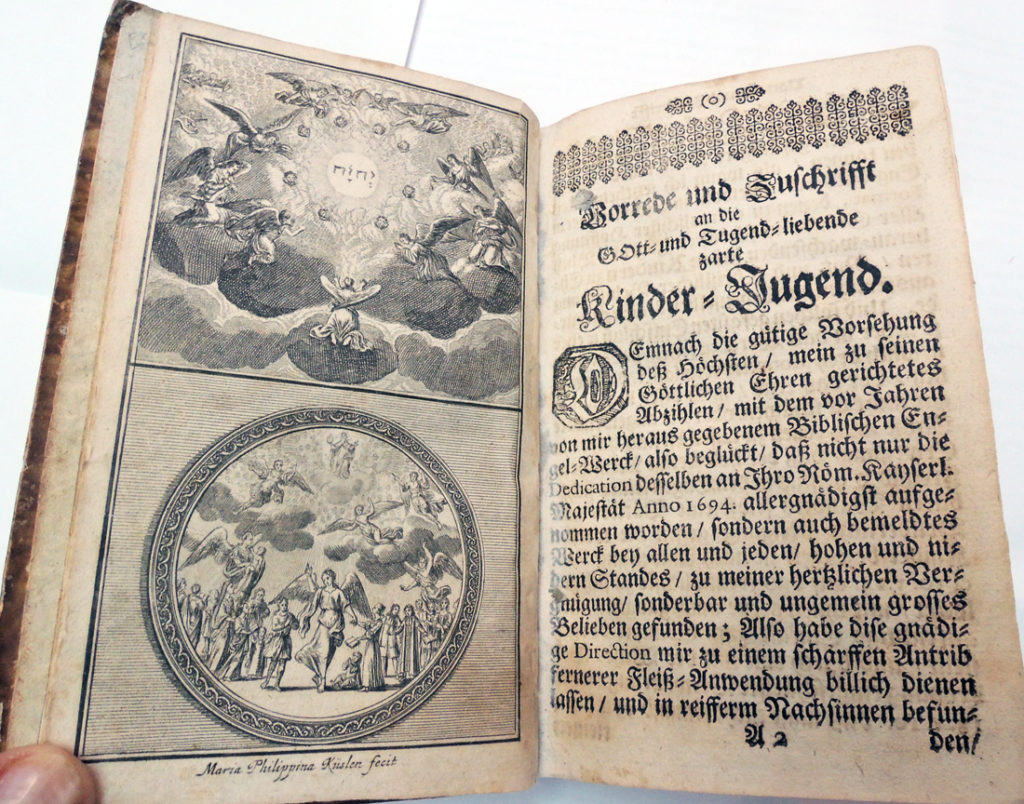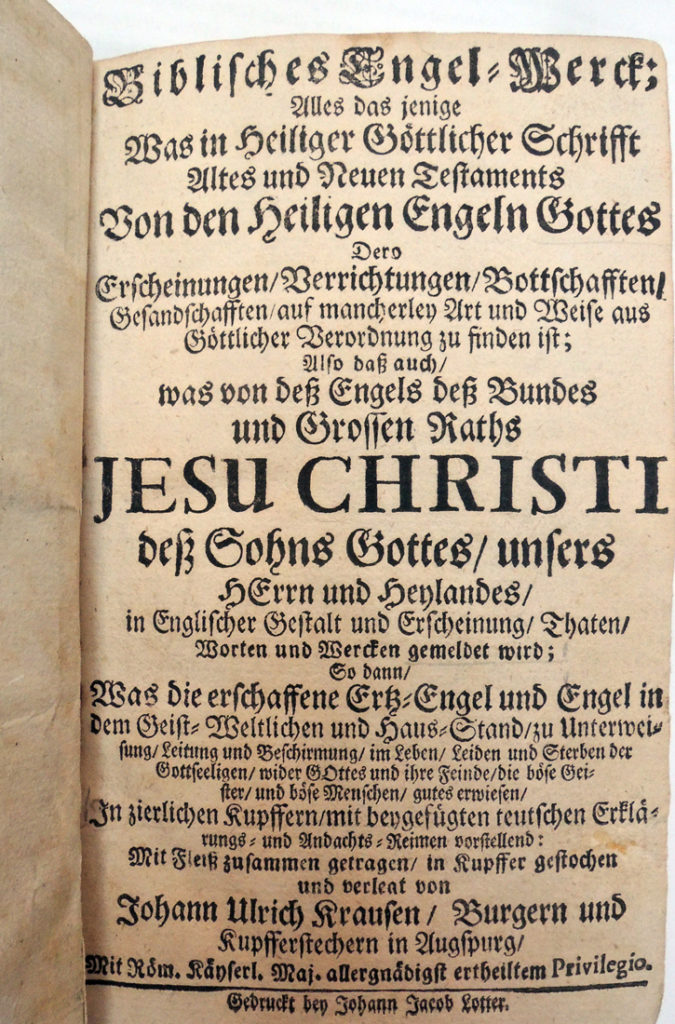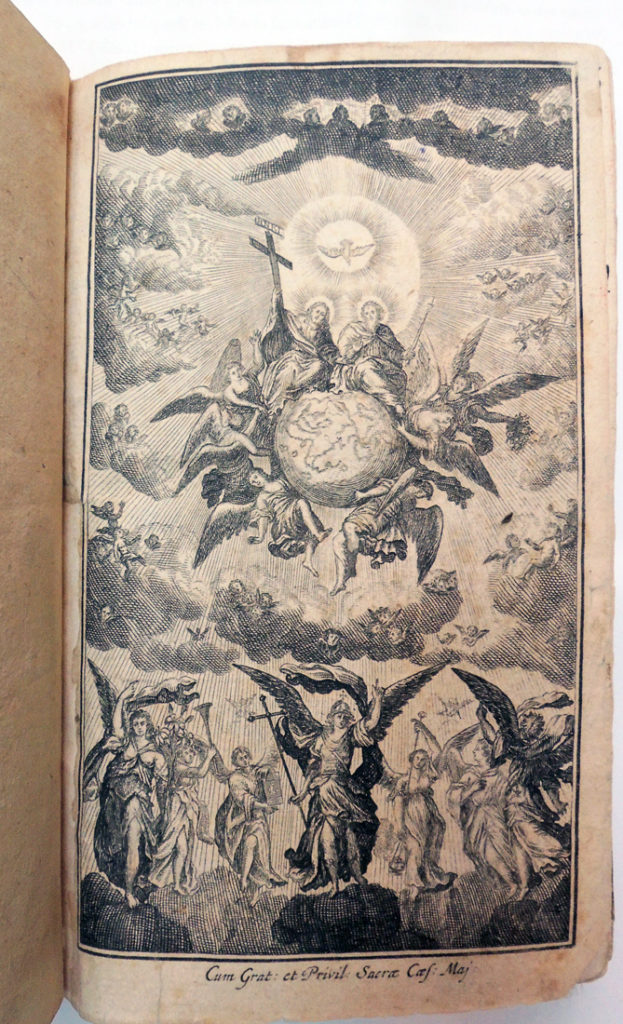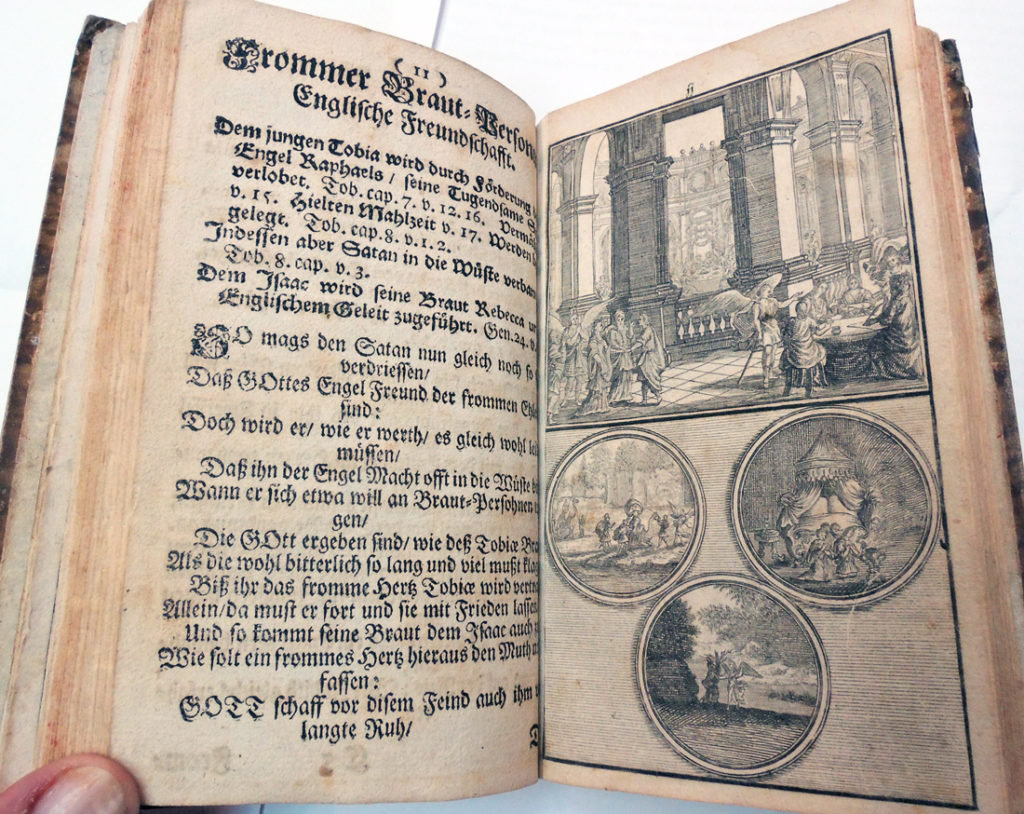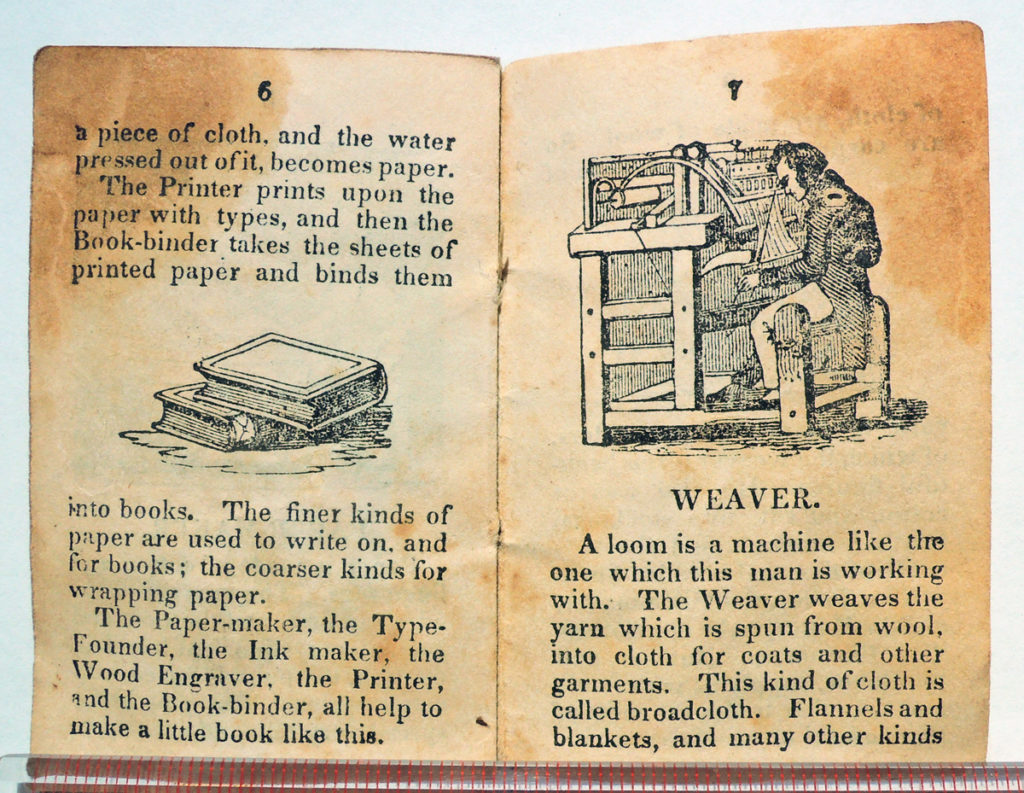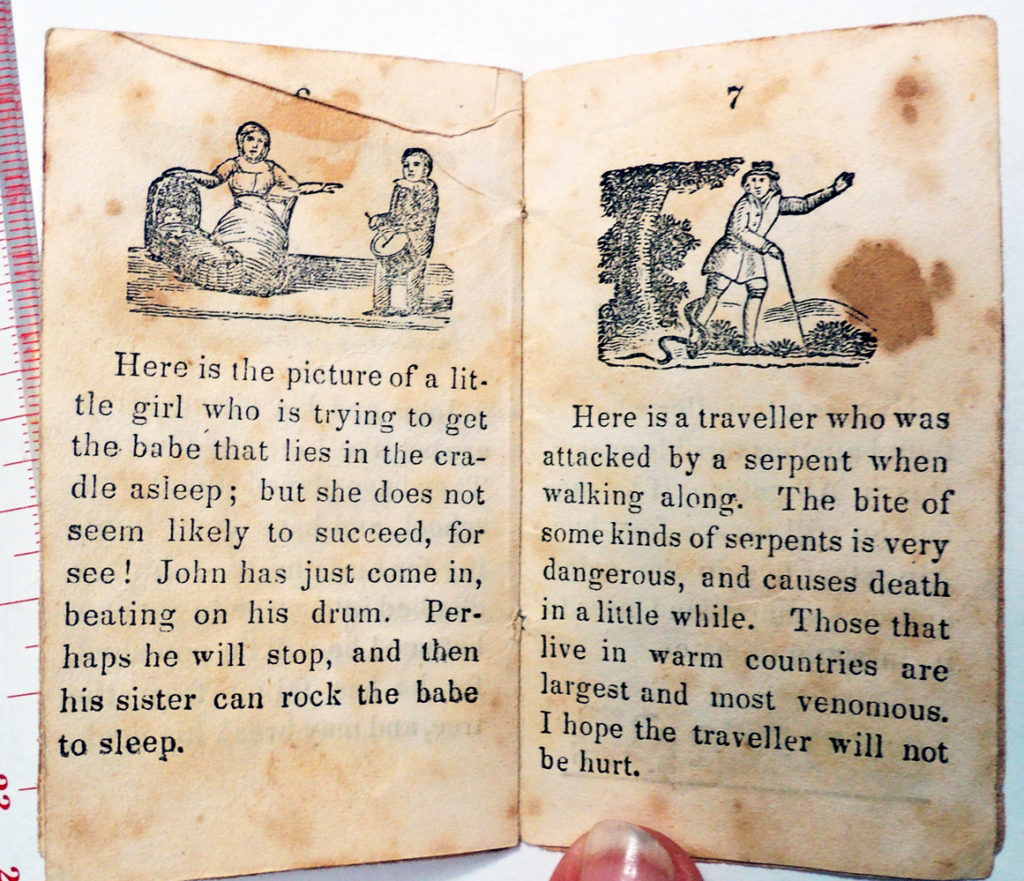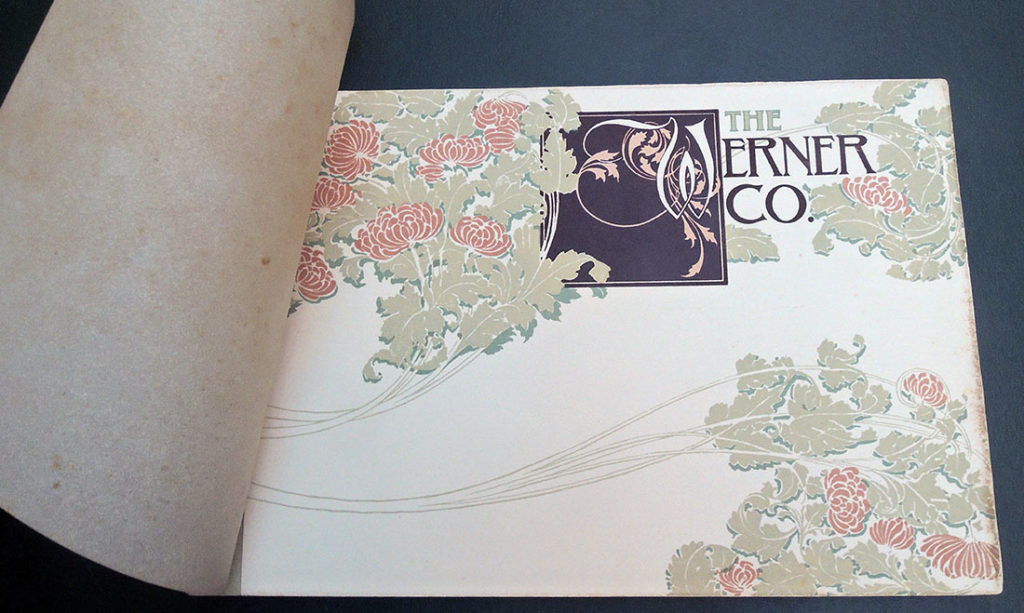
A recent acquisition of a small, ephemeral booklet from 1894 chronicling The Werner Company, a book publishing firm, led to a wonderful sequence of 42 illustrations depicting the bookmaking process at that time. Here are a few in no particular order:
Category Archives: Illustrated books
Life Begins
Everyone agrees that publisher Henry Luce launched Life magazine on November 23, 1936, his third magazine after Time (1923) and Fortune (1930). The first issue sold for ten cents and featured a cover photograph of Fort Peck Dam in Montana by Margaret Bourke-White, five pages of Alfred Eisenstaedt’s photographs, and dozens of other photo-essays. The magazine’s circulation went from 380,000 the first week to more than one million four months later, lasting until 1972. Paper issues can be seen at: ReCAP Oversize 0901.L724q
What no one seems to agree on is why someone made a miniature facsimile edition of the first issue, seen here along with the bound original. Some collections call is a salesman’s sample but it seems unlikely Luce would reproduce the entire issue in miniature when he was pushing the large format image.
More likely is that a facsimile was made as a souvenir or keepsake, either at the moment or for a later anniversary. There is nothing in the issue to indicate why or when it was produced, and no information online to settle the question. A call to Time, Inc. did not add any useful information. Happily for us, the facsimile includes the back cover [above], which was removed from our paper issues. 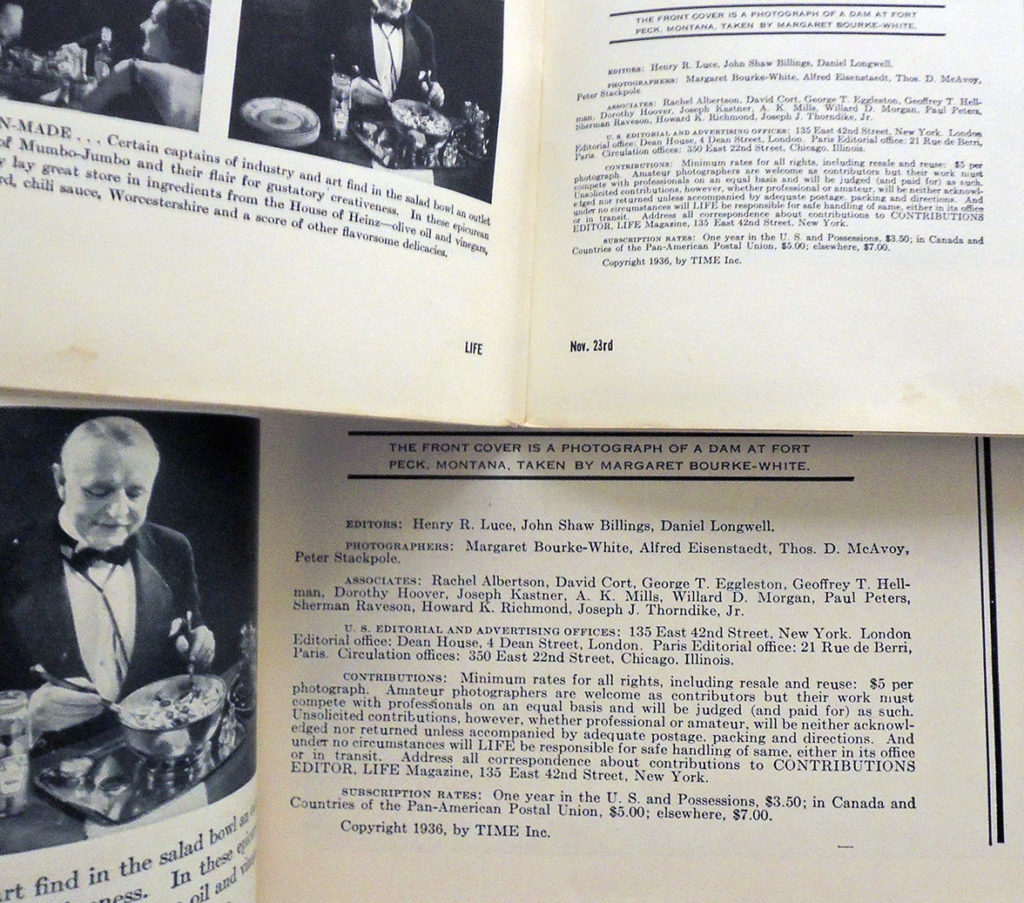
Color printing by Jean Robert, assistant to J. C. Le Blon
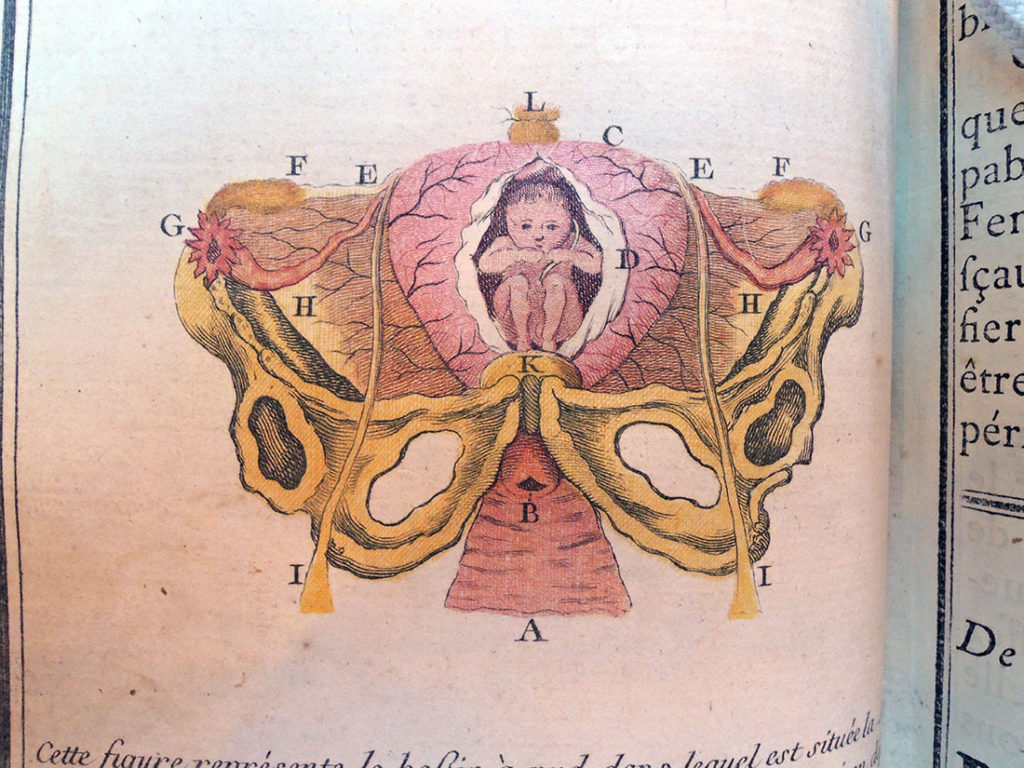
For those who study the history of printed color, the German printer Jacob Christoph Le Blon (1667-1741) is celebrated for his development of three and four color prints. We usually think of the deluxe editions he produced but forget his three-color system was also used on simple, utilitarian volumes.
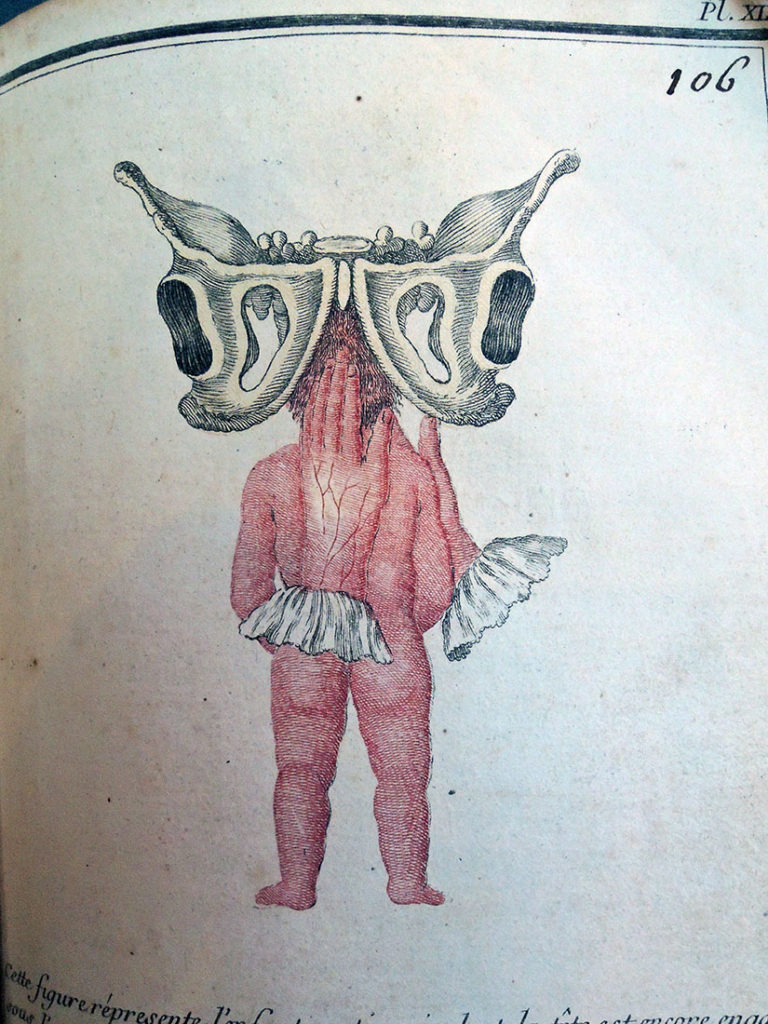 Thanks go to Charles B. Wood III, who found this work on obstetrics by Angélique Marguerite Le Boursier Du Coudray (1712-1789). the pioneering midwife who published the manual on childbirth, developed from the lectures and classes she gave throughout Europe. The illustrations are beautifully printed in colors by Le Blon’s assistant Jean Robert (active 1746-1782) and the frontispiece portrait of Du Coudray is also engraved by Robert.
Thanks go to Charles B. Wood III, who found this work on obstetrics by Angélique Marguerite Le Boursier Du Coudray (1712-1789). the pioneering midwife who published the manual on childbirth, developed from the lectures and classes she gave throughout Europe. The illustrations are beautifully printed in colors by Le Blon’s assistant Jean Robert (active 1746-1782) and the frontispiece portrait of Du Coudray is also engraved by Robert.
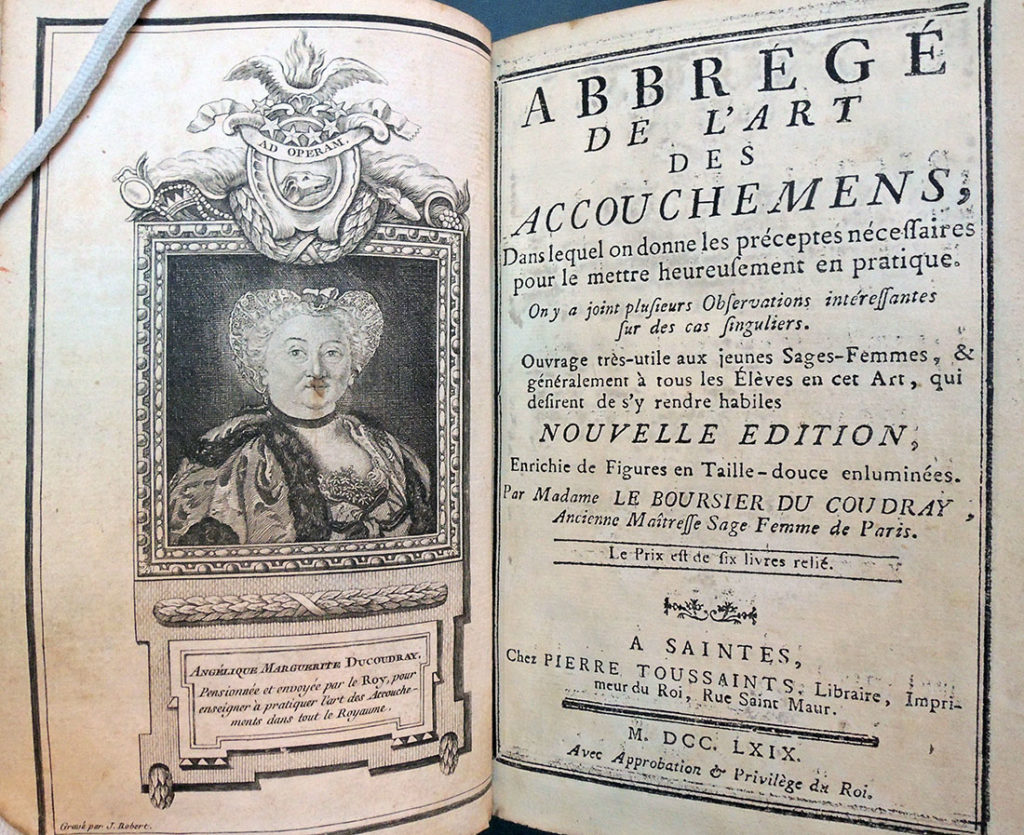 Angélique Marguerite Le Boursier du Coudray (1715-1794), Abbrégé de l’art des accouchemens, dans lequel on donne les préceptes nécessaires pour le mettre heureusement en pratique. On y a joint plusieurs observations intéressantes sur des cas singuliers. Ouvrage très-utile aux jeunes Sages-Femmes, & généralement à tous les éléves en cet art, qui désirent de s’y rendre habiles. Nouvelle édition, enrichie de figures en taille-douce enluminées. Par Madame Le Boursier du Coudray, ancienne maîtresse sage-femme de Paris (Saintes: Pierre Toussaints. Libraire, imprimeur du Roi, rue Saint Maur. M. DCC. LXIX [1769]). Rare Books and Special Collections RG93 .xD8
Angélique Marguerite Le Boursier du Coudray (1715-1794), Abbrégé de l’art des accouchemens, dans lequel on donne les préceptes nécessaires pour le mettre heureusement en pratique. On y a joint plusieurs observations intéressantes sur des cas singuliers. Ouvrage très-utile aux jeunes Sages-Femmes, & généralement à tous les éléves en cet art, qui désirent de s’y rendre habiles. Nouvelle édition, enrichie de figures en taille-douce enluminées. Par Madame Le Boursier du Coudray, ancienne maîtresse sage-femme de Paris (Saintes: Pierre Toussaints. Libraire, imprimeur du Roi, rue Saint Maur. M. DCC. LXIX [1769]). Rare Books and Special Collections RG93 .xD8
See also the 1756 book engraved by Pierre François Tardieu (1711–1771) and Jean Robert (active 1746–1782), and printed by Pierre Gilles Le Mercier (active 1735–1766): “Coloritto or the Harmony of Colouring in Painting” in Antoine Gautier de Montdorge (1701-1768), L’art d’imprimer les tableaux, traité d’après les écrits, les opérations & les instructions verbales, de J. C. Le Blon (Paris: Chés P. G. Le Mercier … Jean-Luc Nyon … Michel Lambert … 1756). Graphic Arts Collection 2004-3391N.
Nattini bindings
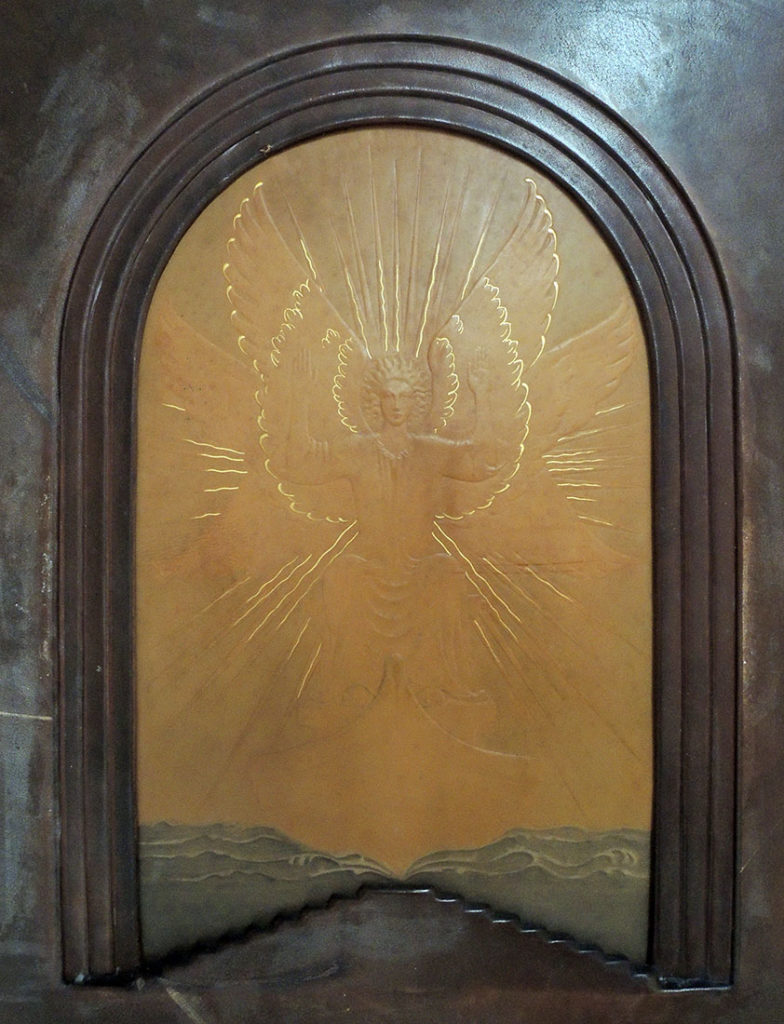 Volume 3 front cover
Volume 3 front cover
The question yesterday was, What is on the back of the Nattini binding?
As first posted in 2011, the Graphic Arts Collection is fortunate to hold one complete bound set of Dante’s Divine Comedy imagined by the artist Amos Nattini (1892-1985), along with one partially unbound set. At 82 cm long and perhaps 20 pound each, these do not move from the shelf often. 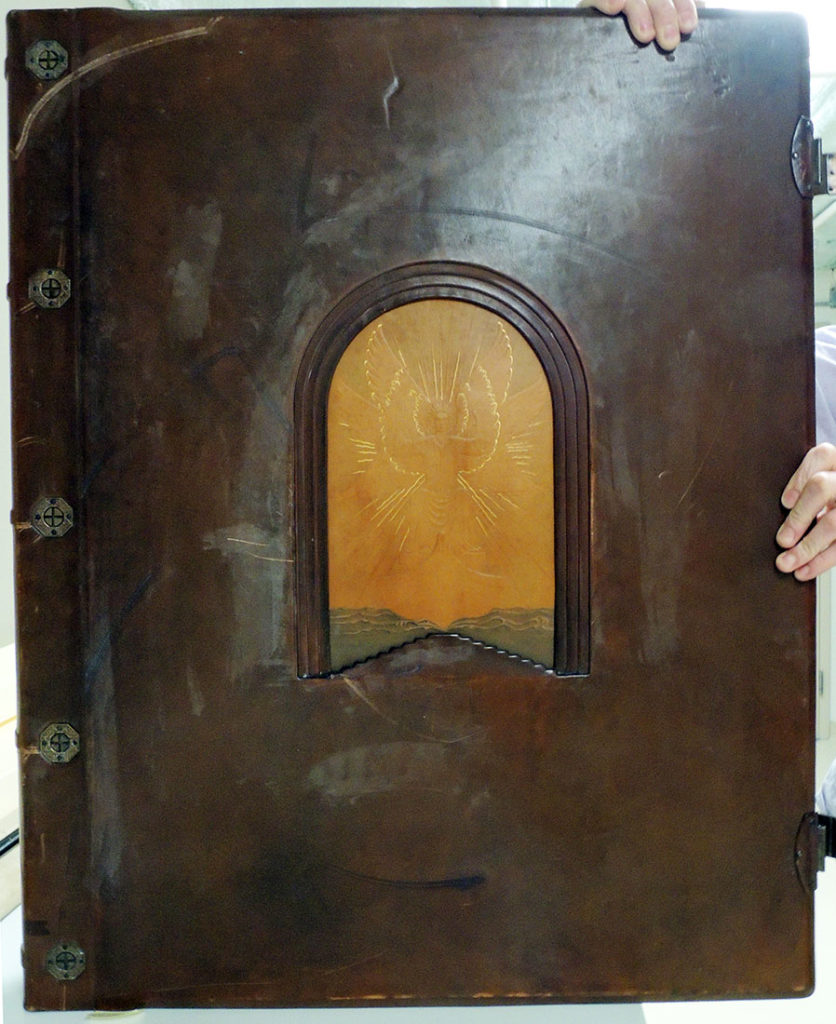
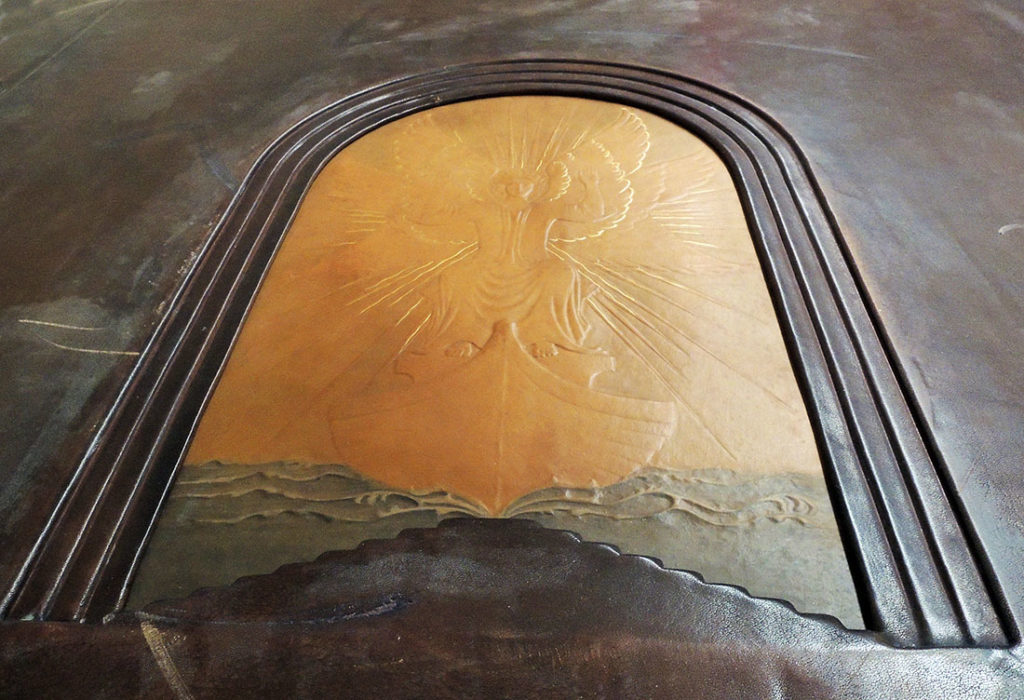 Dante Alighieri (1265-1321), La Divina Commedia, Imagini di Amos Nattini (Milano: Istituto nazionale dantesco, [1923-1941]). GAX Oversize PQ4302 .F23e. Three volumes; 82 cm. each. 100 color lithographs by Amos Nattini (1892-1985). https://www.princeton.edu/~graphicarts/2011/07/amos_nattini.html
Dante Alighieri (1265-1321), La Divina Commedia, Imagini di Amos Nattini (Milano: Istituto nazionale dantesco, [1923-1941]). GAX Oversize PQ4302 .F23e. Three volumes; 82 cm. each. 100 color lithographs by Amos Nattini (1892-1985). https://www.princeton.edu/~graphicarts/2011/07/amos_nattini.html
In 1921, on the occasion of the 600th anniversary of Dante Alighieri’s death, the Istituto nazionale dantesco in Milan commissioned a new, illustrated edition of the poet’s Divine Comedy. The artist chosen for the project was Amos Nattini, who was charged with creating one plate for each canto. For the next twenty years, Nattini worked on his Dante, releasing each of the three volumes are they were completed in 1928, 1936, and finally 1941.
Perhaps because of the length of time between volumes, the first and second are bound with similar designs while the third volume has its own design. Here are the front and back, along with this lovely design for the screws. The books are now heading to conservation for a good cleaning.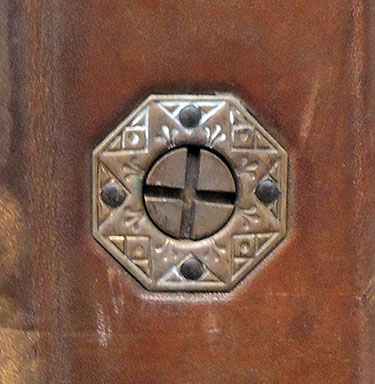
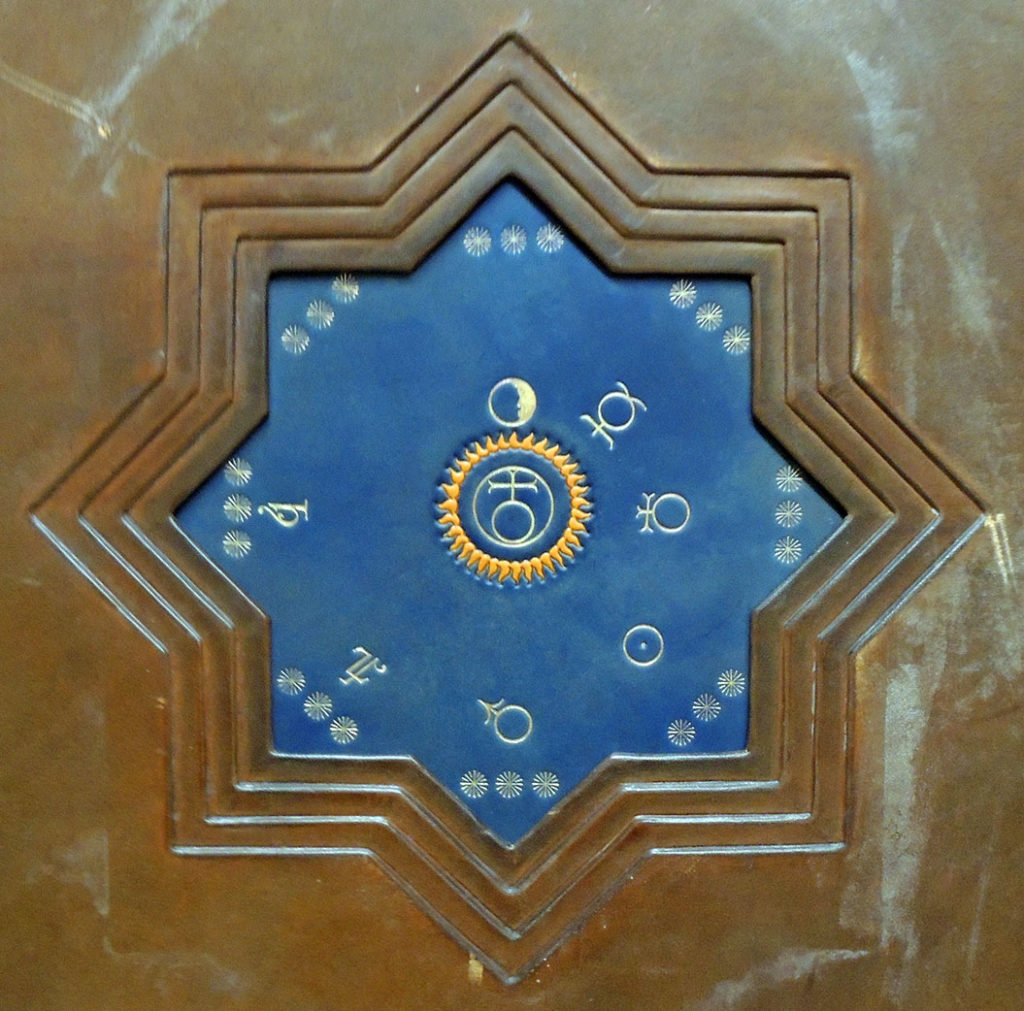 Detail of volume 3 back cover.
Detail of volume 3 back cover.
We are extra fortunate in Princeton, since both the Princeton Theological Seminary and the Institute for Advanced Study Library are listed as also having sets of Nattini’s Dante. This has not been confirmed in person.
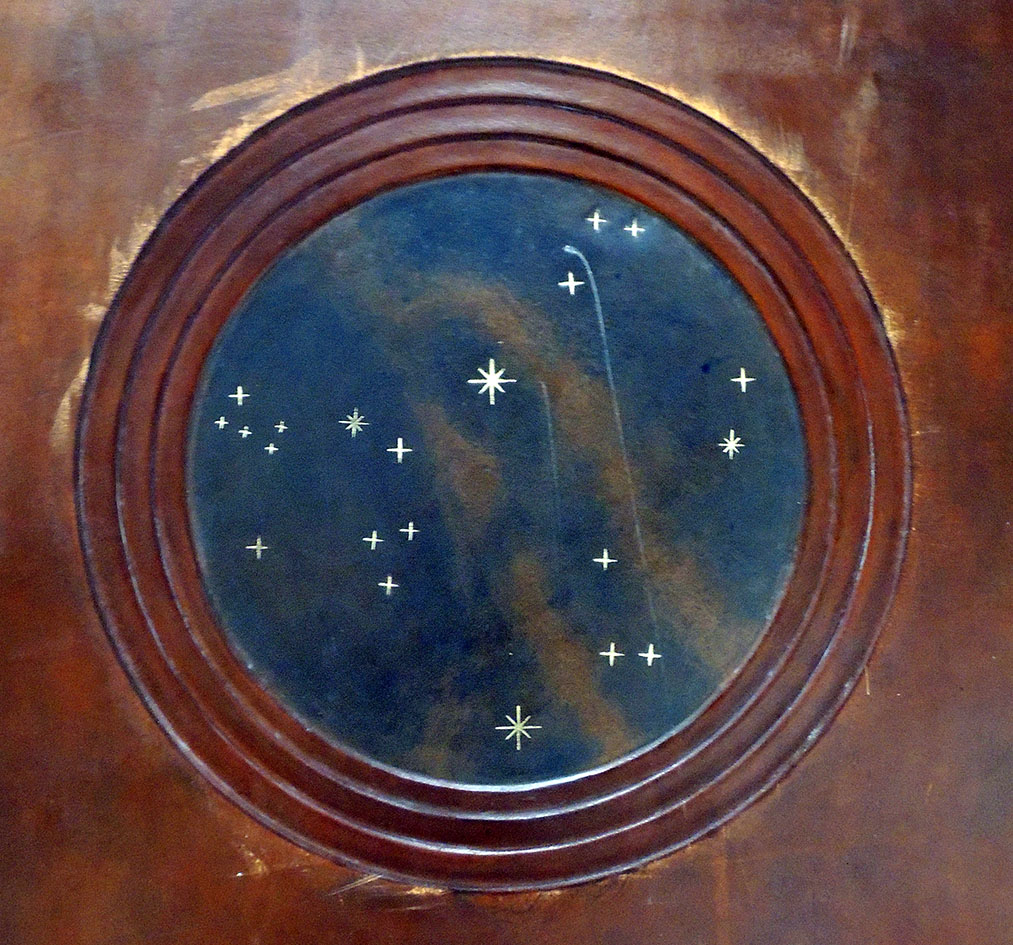 Detail of volume 1 back cover.
Detail of volume 1 back cover.
Special thanks go to Mike Siravo who helped to lift volumes.
Curtis in Alaska
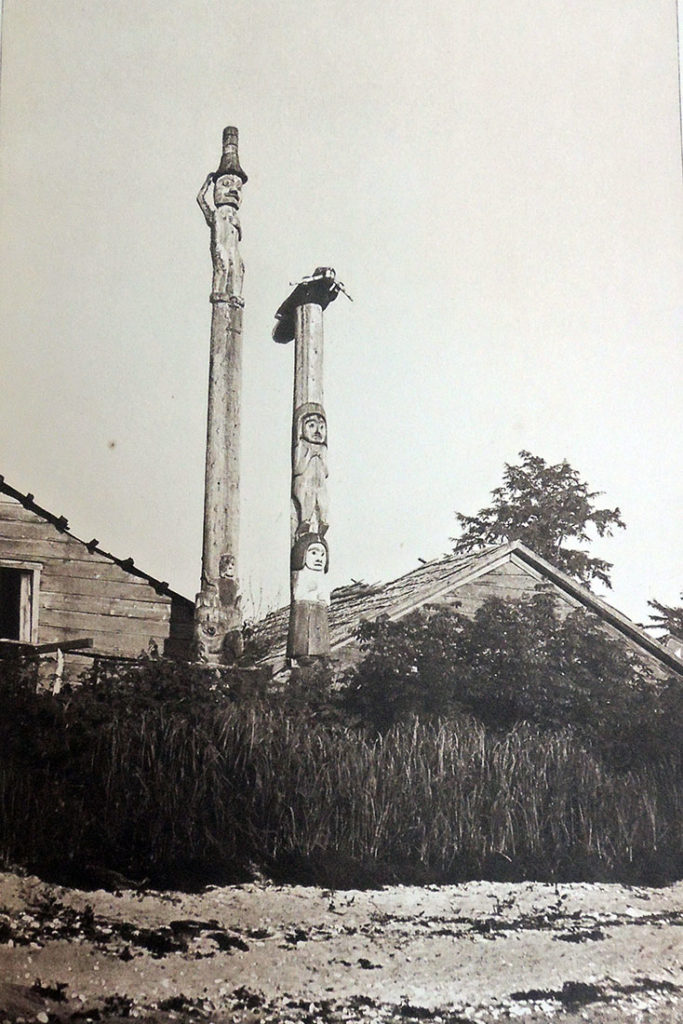 While Edward Curtis (1868-1952) is best remembered for his 2,200 photogravures (ink prints from photographic negatives) published in the 20 volume set, The North America Indian, he began publishing his photographs with images from the Alaskan/Yukon Gold Rush of 1897, and more importantly, as one of the official photographers on E.H. Harriman’s Alaskan expedition of 1899. It was through the Harriman project that Curtis was introduced to the master printers at John Andrew and Son in Boston, who transformed his glass positives into rich aquatinted photogravures. Curtis went on to enlist their services again with his own mammoth series.
While Edward Curtis (1868-1952) is best remembered for his 2,200 photogravures (ink prints from photographic negatives) published in the 20 volume set, The North America Indian, he began publishing his photographs with images from the Alaskan/Yukon Gold Rush of 1897, and more importantly, as one of the official photographers on E.H. Harriman’s Alaskan expedition of 1899. It was through the Harriman project that Curtis was introduced to the master printers at John Andrew and Son in Boston, who transformed his glass positives into rich aquatinted photogravures. Curtis went on to enlist their services again with his own mammoth series.
When Curtis knew them, the engraving firm was in its thirtieth year, run by John’s son George Theodore Andrew (1843-1934) and their technical skill made it worth the cross-country shipping. Although the scale of the Alaska prints does not compare with the prints in The North American Indian, many of the photogravures in Alaska are equally rich in detail and texture.
The Harriman Expedition to Alaska was the last great 19th-century survey of the North American frontier…
Curtis’ relationship with Harriman, Robert Grinnel, a leading ethnographic expert on Native Americans and other members of the party had a great influence on the rest of his life. After a trip of nine thousand miles the party returned with five thousand pictures and over six hundred animal and plant species new to science. New glaciers were mapped and photographed and a new fjord was discovered. Curtis photographed many of the glaciers, but it was his Indian pictures on this trip that established his artistic genius. Curtis produced a souvenir album of photographs for the participants.
http://www.klotzgallery.com/edward-s-curtis-bio

Harriman Alaska Expedition (1899), Alaska… (New York: Doubleday, Page & Company, 1901). “Advertisement. The publication of the series of volumes on the Harriman Alaska Expedition of 1899, heretofore privately printed, has been transferred to the Smithsonian institution by Mrs. Edward H. Harriman, and the work will hereafter be known as the Harriman Alaska series of the Smithsonian institution. The remainder of the edition of volumes I to V, and VIII to XIII, as also volumes VI and VII in preparation, together with any additional volumes that may hereafter appear, will bear special Smithsonian title pages. Smithsonian institution … July, 1910.” ReCAP WA Q115 .H2 1901
Brian O’Doherty/The Structural Plays
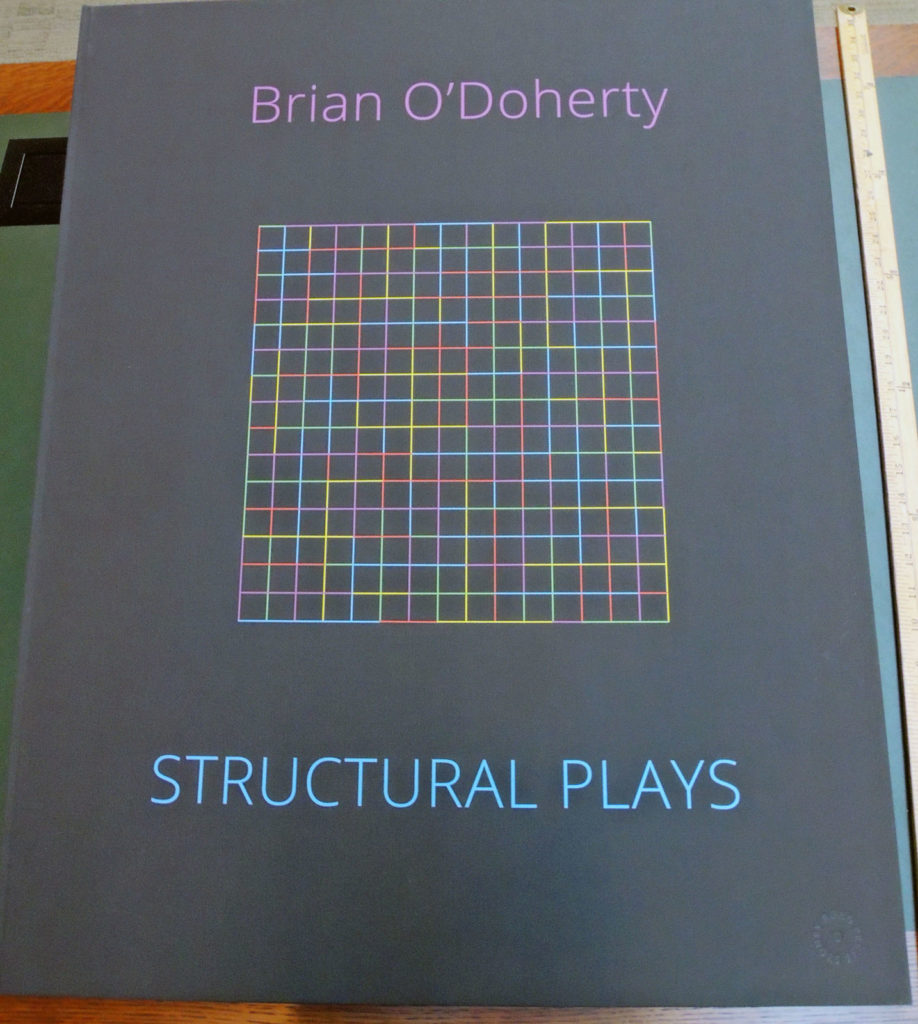 The Graphic Arts Collection received its new copy of Brian O’Doherty/Structural Plays, published by Stoney Road Press, with both pleasure and sadness yesterday. James O’Nolan, co-director of Stoney Road, passed away in July 2018 and so, this will be the last of his beautifully printed books.
The Graphic Arts Collection received its new copy of Brian O’Doherty/Structural Plays, published by Stoney Road Press, with both pleasure and sadness yesterday. James O’Nolan, co-director of Stoney Road, passed away in July 2018 and so, this will be the last of his beautifully printed books.
Based in Dublin, Stoney Road Press is the only independent commercially run fine art print studio in Ireland. An obituary for O’Nolan, published in The Irish Times, July 21, 2018, was titled “Printmaker who made his mark as an artist. His enduring legacy is as a teacher and mentor, and as an interpreter across different media for some of the country’s most distinguished contemporary artists.”
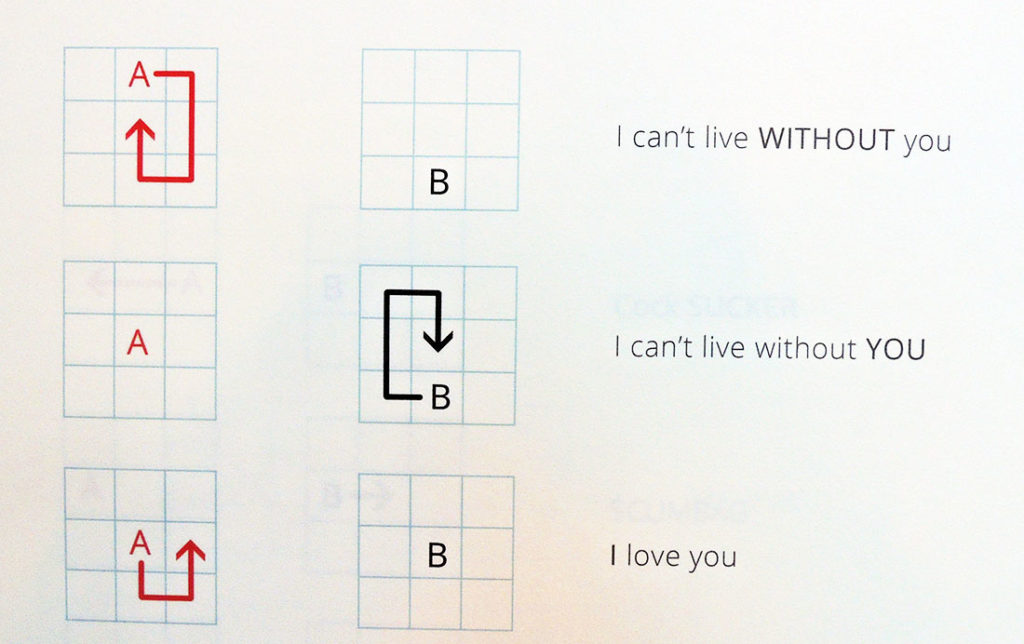
In his work with his business partner David O’Donoghue at the Stoney Road Press (SRP) in Dublin since 2001, James O’Nolan created an internationally renowned fine print press, counting among its clients some of the most prominent names in contemporary Irish art, and setting a globally appreciated standard of excellence which has seen its products displayed in leading galleries throughout Ireland, the UK and the US.
O’Nolan, who has died aged 65 from injuries sustained while cycling in inner-city Dublin, was a self-taught printmaker, and made his mark as an artist in woodblock and carborundum, examples of which are held in public collections such as the National College of Art and Design and the Arts Council. They are described by James Hanley, Keeper of the Royal Hibernian Academy, as having “an intellectual purity of geometric and colour-filled abstraction.” …In his eulogy at O’Nolan’s Humanist funeral service in Dublin this month, Hanley gave a pointed example of this in practice: “Thirty odd years ago, one student [of O’Nolan’s] vacillated and said she had picked textiles, but really wanted to do fine art. James told her firmly, ‘Go . . . and change to fine art.’ The art student concerned was Rachel Joynt, today one of Ireland’s greatest sculptors.”
…O’Nolan came from a particularly renowned Irish family. His father, Kevin, was a Professor of Ancient Classics at University College, Dublin and one of his uncles was Brian O’Nolan, the writer Flann O’Brien, aka the satirist Myles na gCopaleen, columnist with this newspaper. His mother, Maureen Dwyer, who died when he was aged six, was the matron at Glenstal Abbey School where her husband was teaching when James was born. Kevin O’Nolan later remarried, his second spouse being Marie O’Connell, a noted novelist of the period.
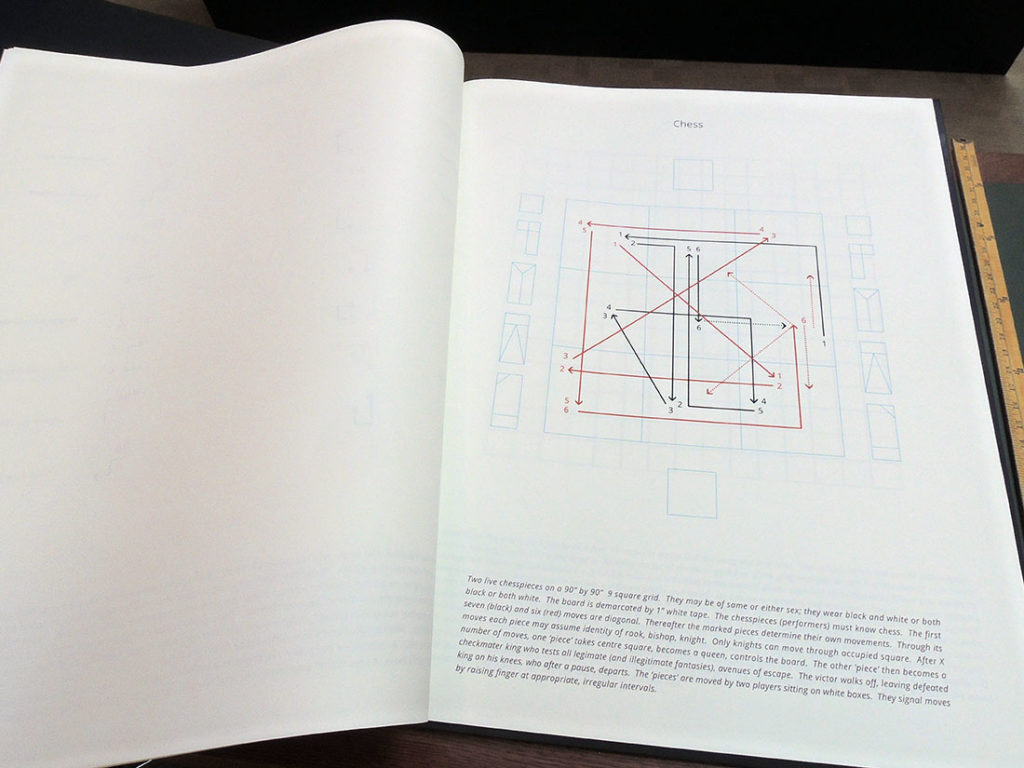 “In re-publishing the Structural Plays,” wrote O’Nolan, “the primary aim was to gather them together in one place, a sort of textbook from which they could be enjoyed, read together, or used as a blueprint to re-create the performances. The original notations are included at the bottom of each. These, together with Brian’s notes on the plays, provide a clear account of how the plays might be performed today.” To page through a digital version, see: https://issuu.com/stoneyroadpress/docs/brian_odoherty_structural_plays-iss
“In re-publishing the Structural Plays,” wrote O’Nolan, “the primary aim was to gather them together in one place, a sort of textbook from which they could be enjoyed, read together, or used as a blueprint to re-create the performances. The original notations are included at the bottom of each. These, together with Brian’s notes on the plays, provide a clear account of how the plays might be performed today.” To page through a digital version, see: https://issuu.com/stoneyroadpress/docs/brian_odoherty_structural_plays-iss

Brian O’Doherty is quoted as saying, “The Ogham Drawings, which preoccupied me for over twenty years, look like drawings, behave like drawings, can be seen as drawings, are drawings, but they also have a voice, that is, they can be spoken and performed. Vowel Grid is a performed drawing.” Many of the structural plays are inspired by Ogham script–an ancient Celtic translation of the Roman alphabet into a writing system of 20 linear characters. 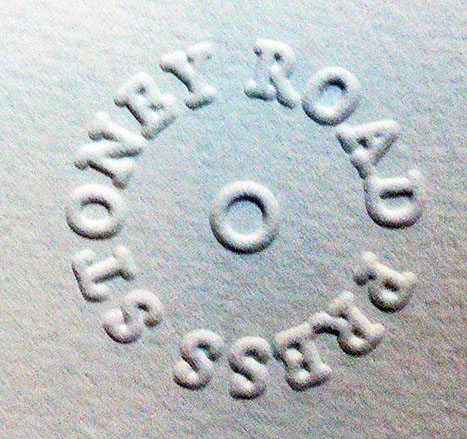
An artist and a teacher, O’Doherty exhibited at Documenta and the Venice Biennale; served as director of both the visual arts and film and media programs at the National Endowment for the Arts; taught film and art criticism at Barnard College and Long Island University; and has written two works of fiction, The Strange Case of Mademoiselle P. and The Deposition of Father McGreevy, which was nominated for the Booker Prize in 2000. He received the College Art Association’s Mather Award for art criticism in 1965 and was a visiting scholar at the Getty Research Institute in 2009–2010.
Maria Philippina Küsel’s Angels
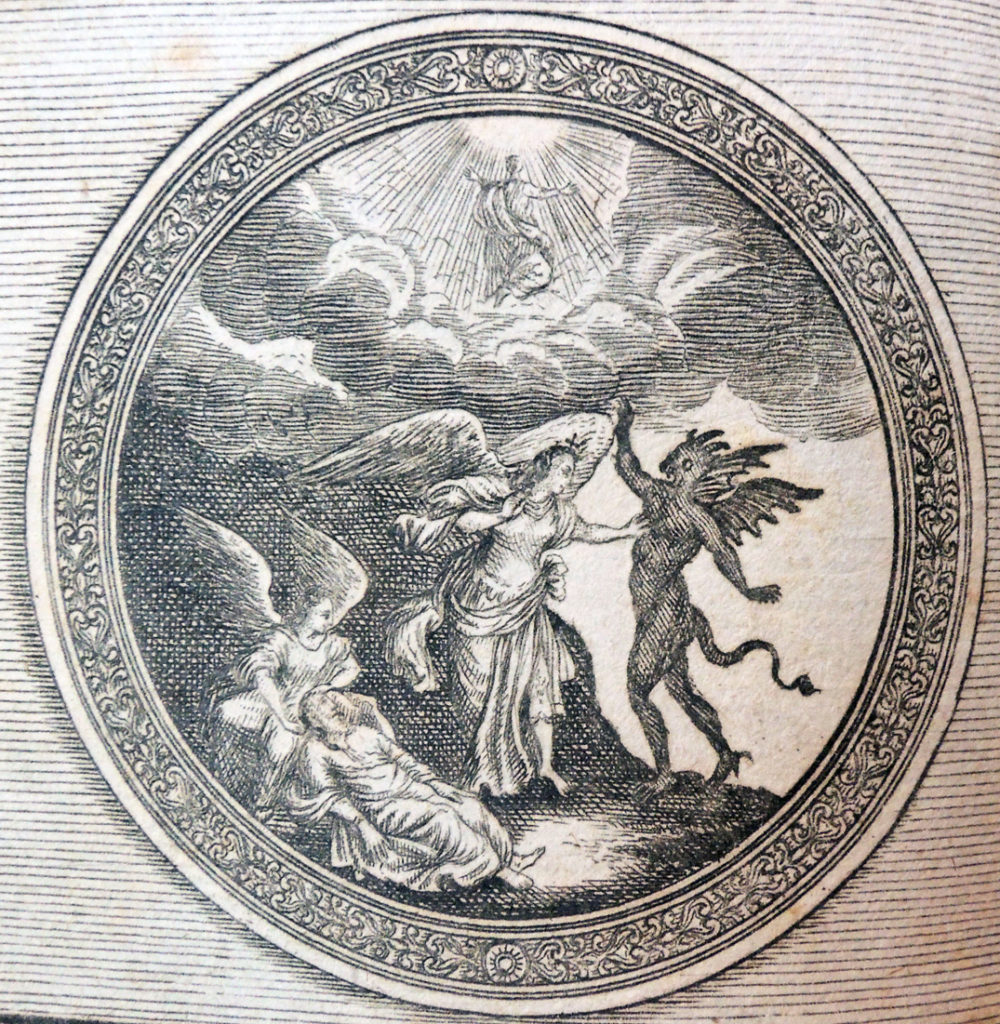 Johann Ulrich Krauss (1645-1719), Biblisches Engel-Werck: alles das jenige Was in Heiliger Göttlicher Schrifft Altes und Neuen Testaments Von den Heiligen Engeln Gottes Dero Erscheinungen, Verrichtungen, Bottschafften, Gesandschafften, auf mancherley Art und Weise aus Göttlicher Verodnung zu finden ist … ; In zierlichen Kupffern, mit beygefügten Teutschen Erklärungs- und Andachts Reimen vorstellend... [Biblical Angel-Work: all that which is in Holy Divine Scripture Old and New Testaments of the Holy Angels of God, the apparitions, works, bouquets, ministries, in some ways from divine order are to be found …; In dainty cupids, together with German descriptive and devotional rhymes…] (Augspurg: Gedruckt bey Johann Jakob Lotter, [ca. 1705-1710]). 15 cm.
Johann Ulrich Krauss (1645-1719), Biblisches Engel-Werck: alles das jenige Was in Heiliger Göttlicher Schrifft Altes und Neuen Testaments Von den Heiligen Engeln Gottes Dero Erscheinungen, Verrichtungen, Bottschafften, Gesandschafften, auf mancherley Art und Weise aus Göttlicher Verodnung zu finden ist … ; In zierlichen Kupffern, mit beygefügten Teutschen Erklärungs- und Andachts Reimen vorstellend... [Biblical Angel-Work: all that which is in Holy Divine Scripture Old and New Testaments of the Holy Angels of God, the apparitions, works, bouquets, ministries, in some ways from divine order are to be found …; In dainty cupids, together with German descriptive and devotional rhymes…] (Augspurg: Gedruckt bey Johann Jakob Lotter, [ca. 1705-1710]). 15 cm.
Many academic collections including Princeton hold a copy of Johann Ulrich Krauss’s late 17th-century emblem book of angels but our recently acquired miniature edition (seen here) is extremely rare.
At 15 cm or approximately 6 inches, all the plates have been redrawn and newly engraved for the tiny hands of children. In both editions, the frontispiece and 31 plates were made by Maria Philippina Küsel (born 1676), a member of the celebrated German family of engravers. The daughter of Melchior Küsel I and the niece of Matthäus Küsel, she and her sisters, Maria Magdalene Küsel and Johanna Sibylla Küsel, were admired for their designs and for their technique in copper plate engraving. See volume 20, Hollstein’s German Etchings, Engravings & Woodcuts 1400-1700. Maria Magdalena Küsel to Johann Christoph Laidig (Amsterdam, Van Gendt, 1977). This volume includes Maria Magdalena Küsel (1683-1707), Maria Philippina Küsel (born 1676), Matthäus Küsel (1629-1681), and other family members.
Nina Musinsky has researched this rare volume and writes:
The original Biblisches Engel- u[nd] Kunst Werck, the first of his religious publications, used an innovative visual presentation, which Krauss would follow in his vast Historische Bilder-Bibel (1698-1700): in the uppermost portion of each of the 34 engravings was a large Biblical scene in rectangular format, while the lower half contained a smaller, related scene within ornamental borders. The explanatory caption and 12-line German poem were engraved at the top and between the two parts of the engravings.
In this “baby” edition, the explanatory text for each plate, which reprints the original engraved text, is printed in letterpress on the facing page. The preliminaries are the same, except that this edition replaces the dedication to Kaiser Leopold with a rather humbler dedication to children, a 7-page Vorrede und Zuschrift an die Gott- und Tugend- liebende zarte Kinder-]ugend, in which Krauss declares his desire to plant the seeds of pious habits in children and youth.
Other than the frontispiece, Kusel’s fine engravings modify the plates of the larger edition in various ways. First, they contain no engraved text. Secondly, Kusel’s adaptations of the upper scenes usually eliminate some architectural or background detail, and select salient details to focus on. Most, but not all, are in reverse. In the lower portions are one to five roundels (occasionally overlapping) on unadorned backgrounds, without the elaborate rococo borders of the original plates, the roundels containing an adaptation of the religious scenes shown in the original engraving, once or twice including a new scene not in the original (e.g., plate 10).
Plate wear shows that this edition post-dates the only other known edition of the plates, printed by Johann Christoph Wagner, ca. 1700, for Krauss. This edition is not to be confused with the 1702 edition of the entire Historische Bilder-Bibel, including the Engel- Werck, which contained smaller reversed copies of the original plates, including the engraved text, also by Maria Philippina Kusel and by her sister Johanna Sibylla Krauss. That 1702 edition (of which the Bavarian State Library is digitized) is much larger than this one, the engravings are different, and it includes no letterpress text; nor was it explictly intended for children, as is this one.
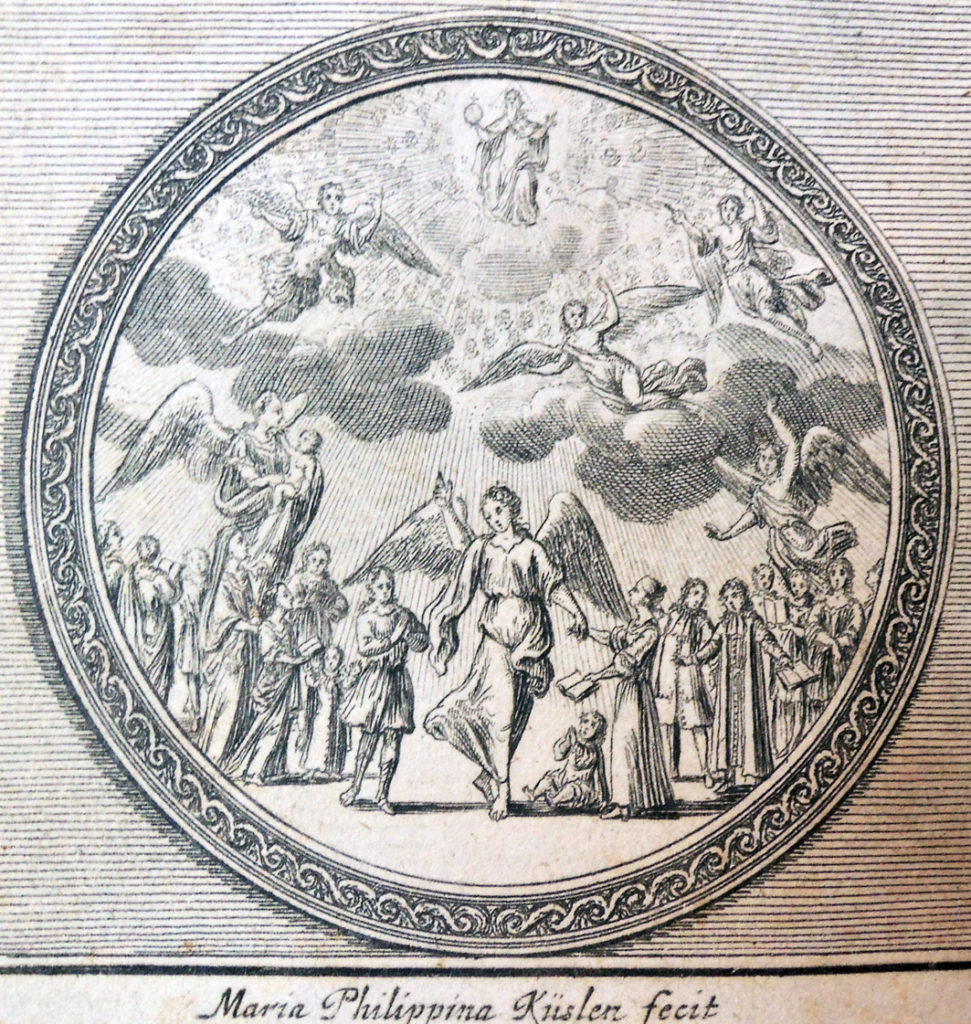 See also Johann Ulrich Krauss (1645-1719), Biblisches Engel- u. Kunst Werck: alles das jenige, was in Heiliger Göttlicher Schrifft Altes und Neuen Testaments von den heiligen Engeln Gottes … zu finden ist … in zierlichen Kupffern, mit beygefügten Teutschen Erklarungs und Andachts- Reimen vorstellend: mit Fleiss zusammen getragen, in Kupfer gestochen und verlegt / von Johann Ulrich Krause … [Biblical Angels and Art Work: all that is to be found in the Holy Divine Scripture of the Old and New Testaments of the Holy Angels of God … in dainty cupids, with attached German explanatory and devotional rhymes presented: together with diligence, engraved in copper by Johann Ulrich Krause] (Augsburg: [Johann Ulrich Krauss], 1694). 35 cm. Rare Books Oversize NE654.K81 A2q
See also Johann Ulrich Krauss (1645-1719), Biblisches Engel- u. Kunst Werck: alles das jenige, was in Heiliger Göttlicher Schrifft Altes und Neuen Testaments von den heiligen Engeln Gottes … zu finden ist … in zierlichen Kupffern, mit beygefügten Teutschen Erklarungs und Andachts- Reimen vorstellend: mit Fleiss zusammen getragen, in Kupfer gestochen und verlegt / von Johann Ulrich Krause … [Biblical Angels and Art Work: all that is to be found in the Holy Divine Scripture of the Old and New Testaments of the Holy Angels of God … in dainty cupids, with attached German explanatory and devotional rhymes presented: together with diligence, engraved in copper by Johann Ulrich Krause] (Augsburg: [Johann Ulrich Krauss], 1694). 35 cm. Rare Books Oversize NE654.K81 A2q
The Photogravures of the American Realists
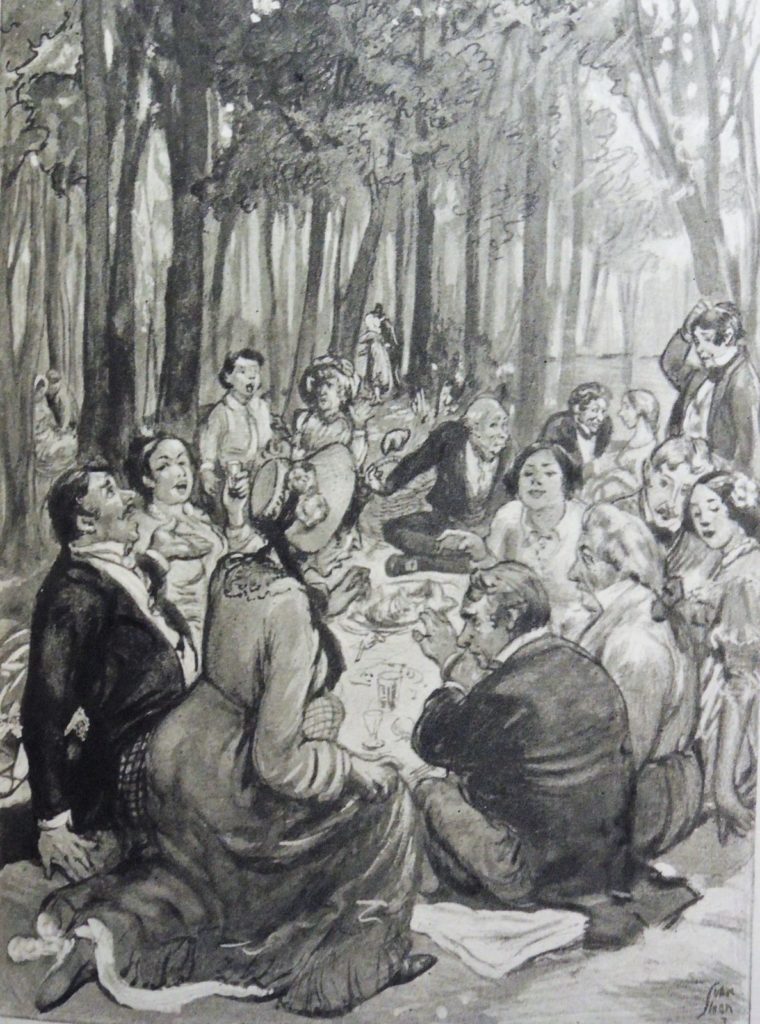 [left] John Sloan, “The Toymaker Sounded a Bacchic Refrain,” photogravure from drawing, v.3, p.66 in Paul de Kock (1793-1871), The Works of Charles Paul de Kock (Boston, MA: Frederick J. Quinby Co., 1902-1904). ReCAP 3261.28.2902
[left] John Sloan, “The Toymaker Sounded a Bacchic Refrain,” photogravure from drawing, v.3, p.66 in Paul de Kock (1793-1871), The Works of Charles Paul de Kock (Boston, MA: Frederick J. Quinby Co., 1902-1904). ReCAP 3261.28.2902
In 1904, William Glackens (1870-1938) was one of several artists commissioned to illustrate a set of the 19th-century French novels of Charles Paul de Kock, translated into English for the Frederick J. Quinby Company of Boston. The plan was to produce fifty volumes in a variety of editions from deluxe to less expensive. When Glackens realized the extent of the project, he contacted his friends John Sloan (1871-1951) and George Benjamin Luks (1867-1933), who were also hired by the Quinby firm.
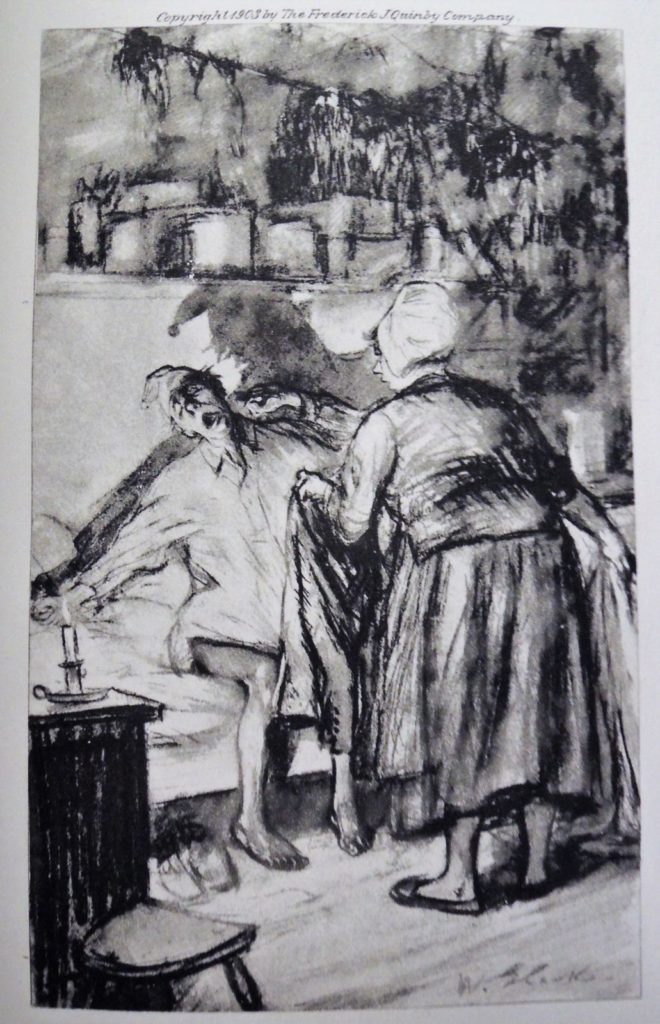 William Glackens, “Here are Your Trousers,” photogravure from drawing, v.16, p.7 in Paul de Kock (1793-1871), The Works of Charles Paul de Kock (Boston, MA: Frederick J. Quinby Co., 1902-1904). ReCAP 3261.28.2902
William Glackens, “Here are Your Trousers,” photogravure from drawing, v.16, p.7 in Paul de Kock (1793-1871), The Works of Charles Paul de Kock (Boston, MA: Frederick J. Quinby Co., 1902-1904). ReCAP 3261.28.2902
Some volumes include the work of several artists, while other novels were reserved for only one. Both etchings and drawings were created and editioned under the direction of the artist before being shipped to Boston. The drawings were primarily reproduced as high-end photogravures, quite an extravagance for such a large series. Eventually the publisher fell behind on payments to the artists and finally declared bankruptcy in 1907, long before all fifty volumes were completed.
 John Sloan, “In Vain Did Dupont Shout, ‘Stop! Stop!” etching, v.4, p.224 in Paul de Kock (1793-1871), The Works of Charles Paul de Kock (Boston, MA: Frederick J. Quinby Co., 1902-1904). ReCAP 3261.28.2902
John Sloan, “In Vain Did Dupont Shout, ‘Stop! Stop!” etching, v.4, p.224 in Paul de Kock (1793-1871), The Works of Charles Paul de Kock (Boston, MA: Frederick J. Quinby Co., 1902-1904). ReCAP 3261.28.2902
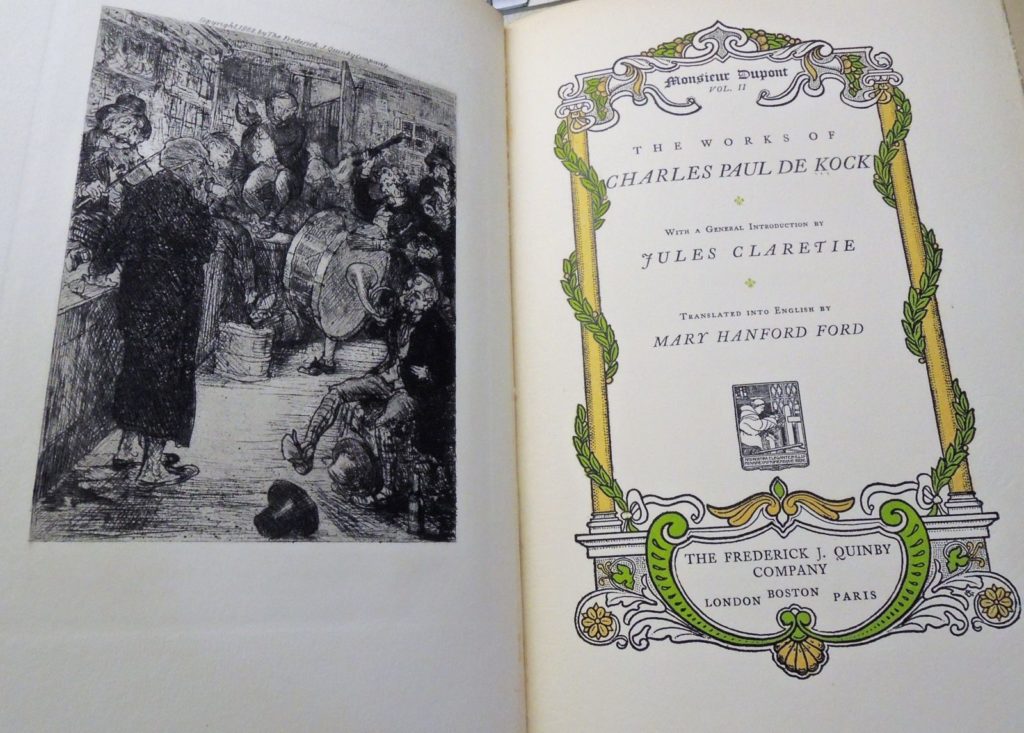 John Sloan, “The Violin Mounted the Counter, The Hunting-Horn Seated Himself Upon the Loaves of Sugar, the Clarinet Upon a Keg of Glue, and the Fife Upon a Barrel of Molasses,” etching, v.4 frontispiece in Paul de Kock (1793-1871), The Works of Charles Paul de Kock (Boston, MA: Frederick J. Quinby Co., 1902-1904). ReCAP 3261.28.2902
John Sloan, “The Violin Mounted the Counter, The Hunting-Horn Seated Himself Upon the Loaves of Sugar, the Clarinet Upon a Keg of Glue, and the Fife Upon a Barrel of Molasses,” etching, v.4 frontispiece in Paul de Kock (1793-1871), The Works of Charles Paul de Kock (Boston, MA: Frederick J. Quinby Co., 1902-1904). ReCAP 3261.28.2902
Both Sloan and Glackens had their etchings editioned by the Peters Brothers in Philadelphia, following the bon à tirer each artist had approved. The photogravures were probably printed by the F. A. Ringler company in New York City.
“F. A. Ringler Company, at 21 and 23 Barclay Street and 26 and 28 Park Place, is called the largest printing-plate establishment in the world. …. The company’s building has over 25,000 square feet of floor space, where 175 skilled employees are engaged. Adjoining the office is the art department, where designs for all kinds of illustrations are made. Above is the electrotyping foundry, for which a whole floor, 50 x 175 feet, is used, and every conceivable invention for the perfect production of duplicate plates. . . . Above is the photoengraving department, in which the half-tone, zinc and copper etchings, and the general processes of engraving are conducted. Eight of the largest cameras, each operated by a separate artist, are required to keep up with the orders. –Kings Handbook of New York City (New York: M. King, 1893). Volume 1.
In 1910 John Quinn purchased a complete set of the etchings Sloan made for the de Kock series, paying (according to Sloan’s diary) $250. Helen Sloan noted that after Quinn’s death the artist bought back the whole collection from Quinn’s estate for $300.
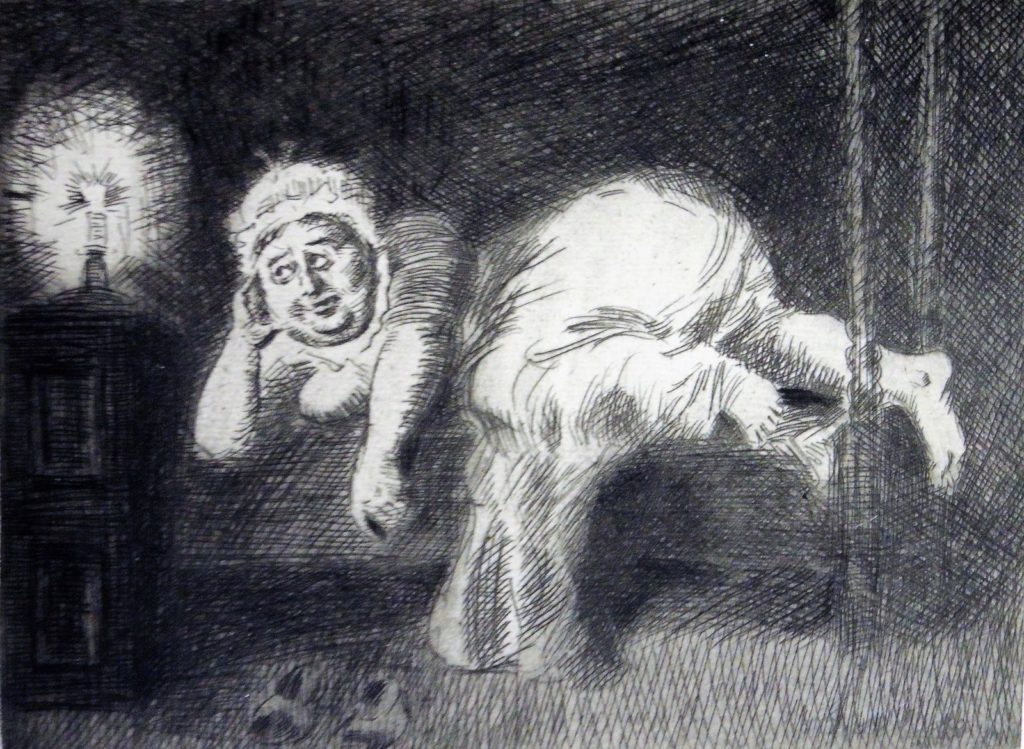 George B. Luks, “Marie-Jeanne … Listened and Waited,” etching, v.22, p.82 in Paul de Kock (1793-1871), The Works of Charles Paul de Kock (Boston, MA: Frederick J. Quinby Co., 1902-1904). ReCAP 3261.28.2902
George B. Luks, “Marie-Jeanne … Listened and Waited,” etching, v.22, p.82 in Paul de Kock (1793-1871), The Works of Charles Paul de Kock (Boston, MA: Frederick J. Quinby Co., 1902-1904). ReCAP 3261.28.2902
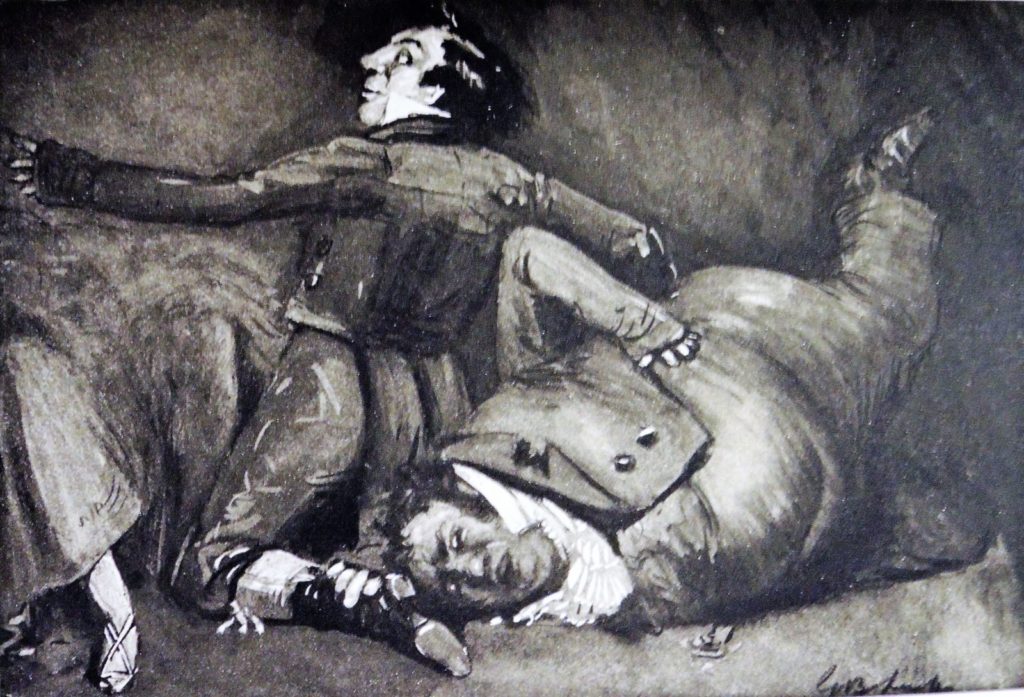 George B. Luks, “The Dear Husband … Fell Down … and Found Himself on Top of Gustave,” photogravure from drawing, v.22, p.45 in Paul de Kock (1793-1871), The Works of Charles Paul de Kock (Boston, MA: Frederick J. Quinby Co., 1902-1904). ReCAP 3261.28.2902
George B. Luks, “The Dear Husband … Fell Down … and Found Himself on Top of Gustave,” photogravure from drawing, v.22, p.45 in Paul de Kock (1793-1871), The Works of Charles Paul de Kock (Boston, MA: Frederick J. Quinby Co., 1902-1904). ReCAP 3261.28.2902
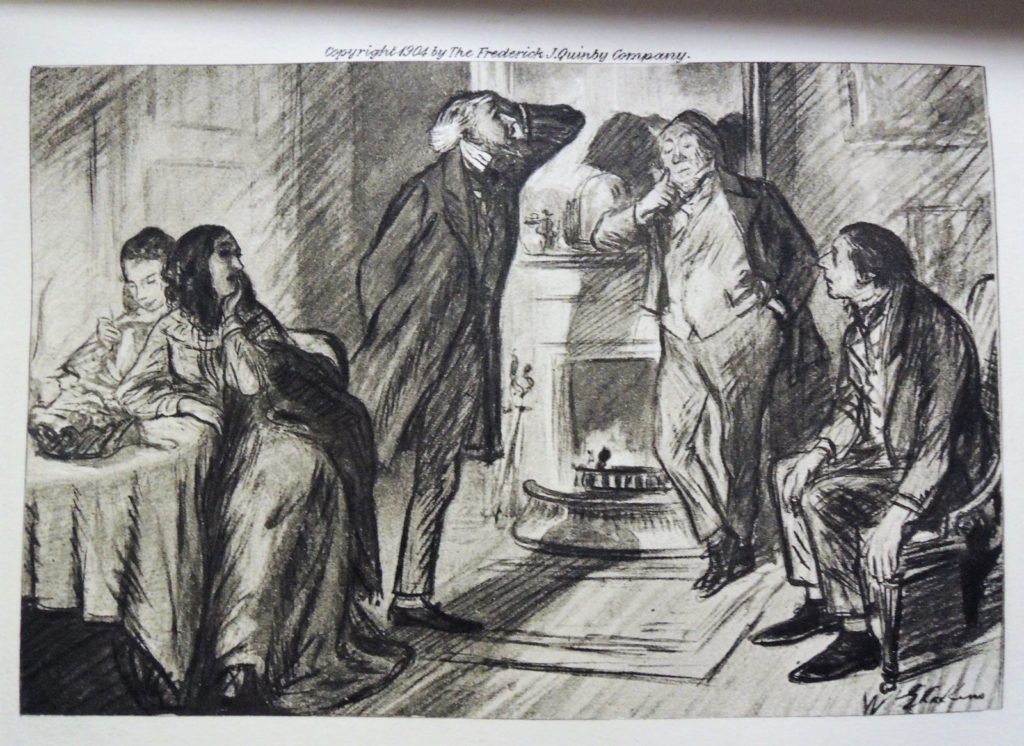 William Glackens, “Edmond Rose and Walked about the Room,” photogravure from drawing, v.20, p.23 in Paul de Kock (1793-1871), The Works of Charles Paul de Kock (Boston, MA: Frederick J. Quinby Co., 1902-1904). ReCAP 3261.28.2902
William Glackens, “Edmond Rose and Walked about the Room,” photogravure from drawing, v.20, p.23 in Paul de Kock (1793-1871), The Works of Charles Paul de Kock (Boston, MA: Frederick J. Quinby Co., 1902-1904). ReCAP 3261.28.2902
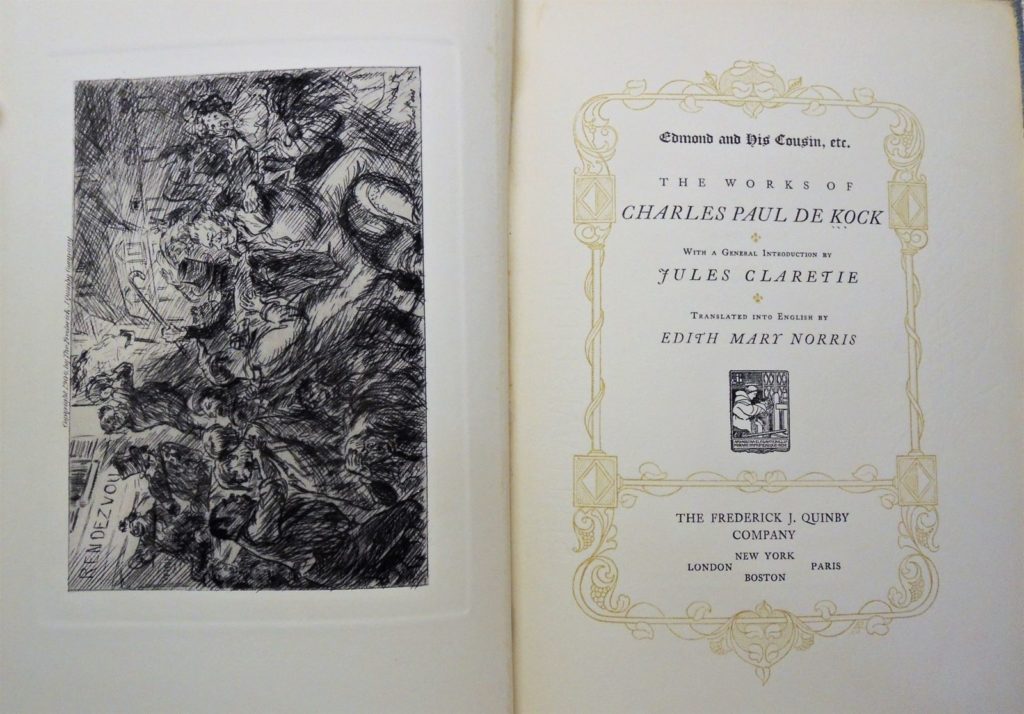 William Glackens, “By Jove! Everybody Was Fighting, and I Did Like the Others,” etching, v.20 frontispiece in Paul de Kock (1793-1871), The Works of Charles Paul de Kock (Boston, MA: Frederick J. Quinby Co., 1902-1904). ReCAP 3261.28.2902
William Glackens, “By Jove! Everybody Was Fighting, and I Did Like the Others,” etching, v.20 frontispiece in Paul de Kock (1793-1871), The Works of Charles Paul de Kock (Boston, MA: Frederick J. Quinby Co., 1902-1904). ReCAP 3261.28.2902
Art Across the Gutter
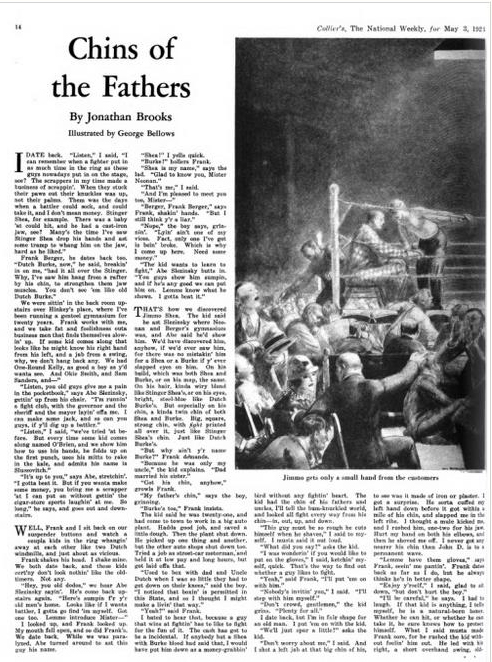 The Fogg Art Museum at Harvard University holds the drawing “Ringside Seats” by George Bellows (1882-1925), which caused tremendous headaches for the artist when Collier’s magazine [ReCAP Oversize 0901.C711q] used it to illustrate the story “Chins of the Fathers” by Jonathan Brooks in the May 3, 1924 issue.
The Fogg Art Museum at Harvard University holds the drawing “Ringside Seats” by George Bellows (1882-1925), which caused tremendous headaches for the artist when Collier’s magazine [ReCAP Oversize 0901.C711q] used it to illustrate the story “Chins of the Fathers” by Jonathan Brooks in the May 3, 1924 issue.
Bellows was promised $400 for this single drawing in graphite, black chalk, pastel and lithographic crayon along with scratchwork and stumping on smooth surfaced multi-ply cream wove paper. However, Collier‘s reproduced it as a double-page spread, the gutter slicing the single picture into two, along with cropping it on the right and in the middle. Bellows was furious.
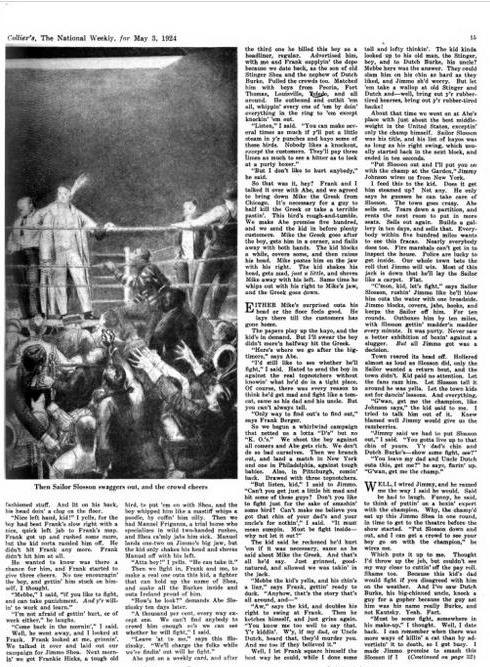 Bellows sent the magazine a new invoice charging $800 for two drawings. As transcribed in Charles Morgan’s George Bellows Painter of America (1979), he continued:
Bellows sent the magazine a new invoice charging $800 for two drawings. As transcribed in Charles Morgan’s George Bellows Painter of America (1979), he continued:
“If there were any way of suing you for libel on the reproductions I would do so. To trim, cut, and otherwise mutilate an artist’s work is quite analogous to misrepresentation before the public, in this case going as far as criminal libel… It is time for publishers to be taught a lesson on this score for their guidance on the rare occasions when they deal with the work of serious artists.”
“…Not only have you shown the worst of taste, and a total lack of consideration for me, you are also guilty of [a snide trick.] Sanding the sugar, watering the milk, stretching one into two. Instead of appearing then before the public as having created one beautiful drawing, in which the proportion of light and shade was basic, I am shown by you as having made two rotten drawings in which [with] your trimming and cutting light and shade is completely destroyed. I therefore intend at least to be paid for the “two” rotten drawings, as per contract…”
Bellows hired Judge Van Slyke and sued the magazine, while continuing to work on an oil painting after the drawing. On July 14, Van Slyke sent a telegram “Defendant’s motion of Judgment denied, Judge holding that your picture was mutilated, its artistic merit destroyed and that our action for libel is maintainable. Congratulations!”
Sadly, Bellows died of peritonitis on January 8, 1925, resulting from a ruptured appendix, never seeing the lawsuit to its close.
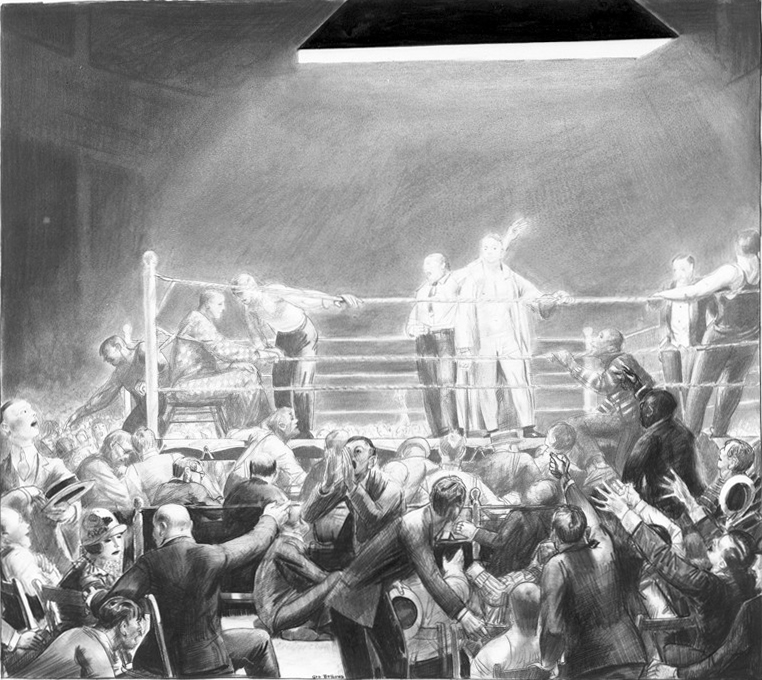 George Wesley Bellows, Ringside Seats, 1924. Graphite and chalk drawing. Fogg Art Museum, Harvard Art Museums
George Wesley Bellows, Ringside Seats, 1924. Graphite and chalk drawing. Fogg Art Museum, Harvard Art Museums
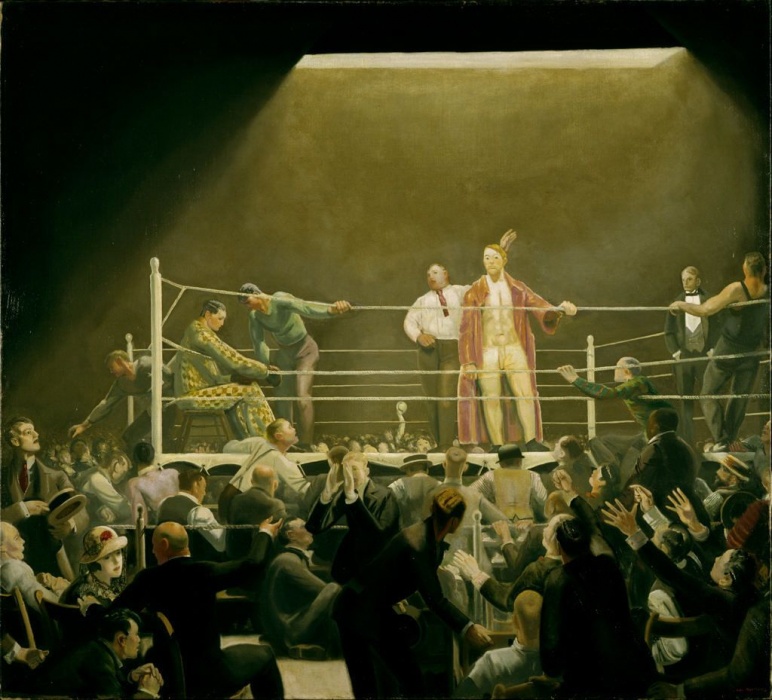 George Wesley Bellows, Ringside Seats, 1924. Oil on Canvas. Hirshhorn Museum and Sculpture Garden, Smithsonian Institution.
George Wesley Bellows, Ringside Seats, 1924. Oil on Canvas. Hirshhorn Museum and Sculpture Garden, Smithsonian Institution.
New chapbooks
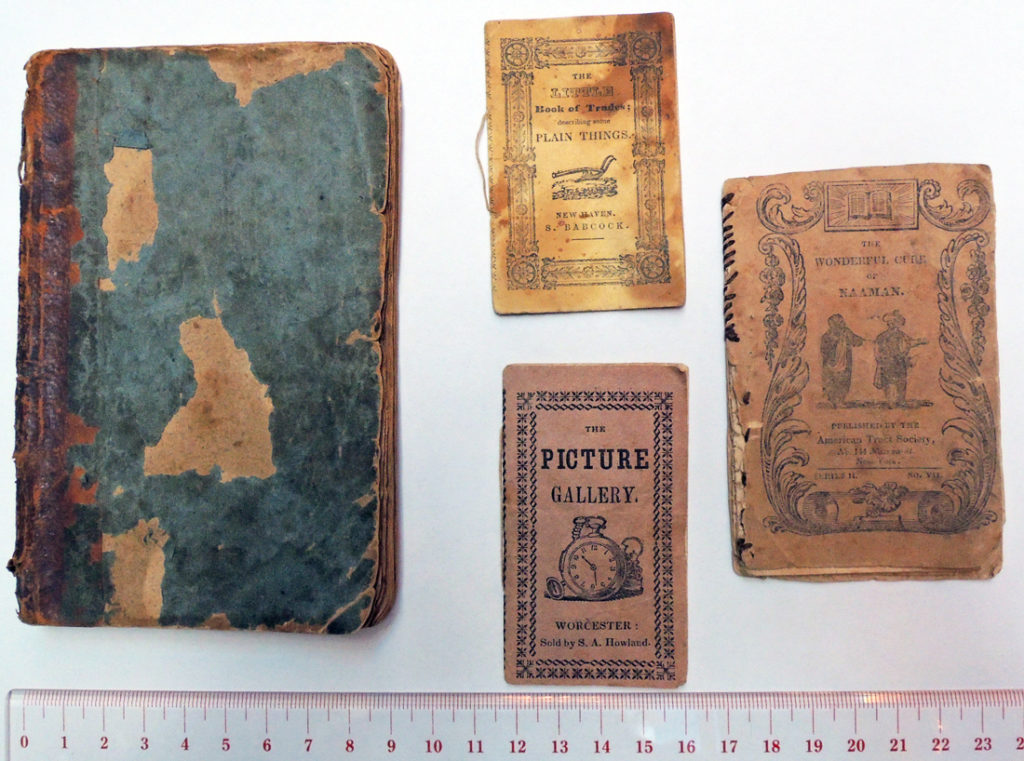 Here is a small taste of the over one hundred volumes that showed up at our door this week, thanks to the generosity of Bruce Willsie, Class of 1986. The collection of early 19th-century chapbooks includes Jewish history, international fiction, education, and much more. It is a beautiful complement to the Sinclair Hamilton Collection of Early American Book Illustrators and Wood Engravers. [scale is centimeters]
Here is a small taste of the over one hundred volumes that showed up at our door this week, thanks to the generosity of Bruce Willsie, Class of 1986. The collection of early 19th-century chapbooks includes Jewish history, international fiction, education, and much more. It is a beautiful complement to the Sinclair Hamilton Collection of Early American Book Illustrators and Wood Engravers. [scale is centimeters]
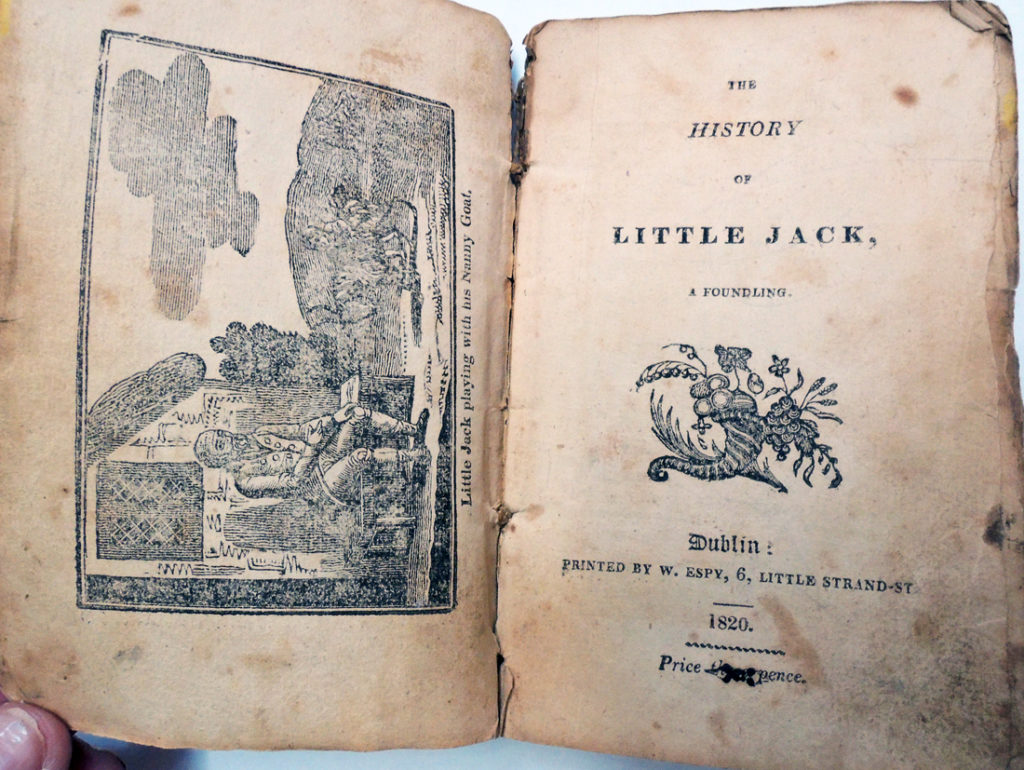 A man and his goat: “There was once a poor lame old man that lived in the midst of a wide uncultivated moor, in the north of England. He had formerly been a soldier, and had almost lost the use of one leg by a wound he had received in battle, when he was fighting against the enemies of his country. This poor man when he found himself thus disabled, built a hut of clay, which he covered with turf dug from the common. …In his walks over the common, he one day found a little kid that had lost its mother, and was almost famished with hunger: he took it home to his cottage, fed it with the produce of his garden, and nursed it till it grew strong and vigorous. Little Nan (for that was the name he gave it) returned his cares with gratitude, and became as much attached to him as a dog. All day she browzed upon the herbage that grew around his hut, and at night reposed upon the same bed of straw with her master. Frequently did she divert him with her innocent tricks, and gambols. She would nestle her little head in his bosom, and eat out of his hand part of his scanty allowance of bread, which he never failed to divide with his favourite. The old man often beheld her with silent joy, and, in the innocent feelings of his heart, would lift his hands to heaven, and thank the Deity, that, even in the midst of poverty and distress, had raised him up one faithful friend.”
A man and his goat: “There was once a poor lame old man that lived in the midst of a wide uncultivated moor, in the north of England. He had formerly been a soldier, and had almost lost the use of one leg by a wound he had received in battle, when he was fighting against the enemies of his country. This poor man when he found himself thus disabled, built a hut of clay, which he covered with turf dug from the common. …In his walks over the common, he one day found a little kid that had lost its mother, and was almost famished with hunger: he took it home to his cottage, fed it with the produce of his garden, and nursed it till it grew strong and vigorous. Little Nan (for that was the name he gave it) returned his cares with gratitude, and became as much attached to him as a dog. All day she browzed upon the herbage that grew around his hut, and at night reposed upon the same bed of straw with her master. Frequently did she divert him with her innocent tricks, and gambols. She would nestle her little head in his bosom, and eat out of his hand part of his scanty allowance of bread, which he never failed to divide with his favourite. The old man often beheld her with silent joy, and, in the innocent feelings of his heart, would lift his hands to heaven, and thank the Deity, that, even in the midst of poverty and distress, had raised him up one faithful friend.”
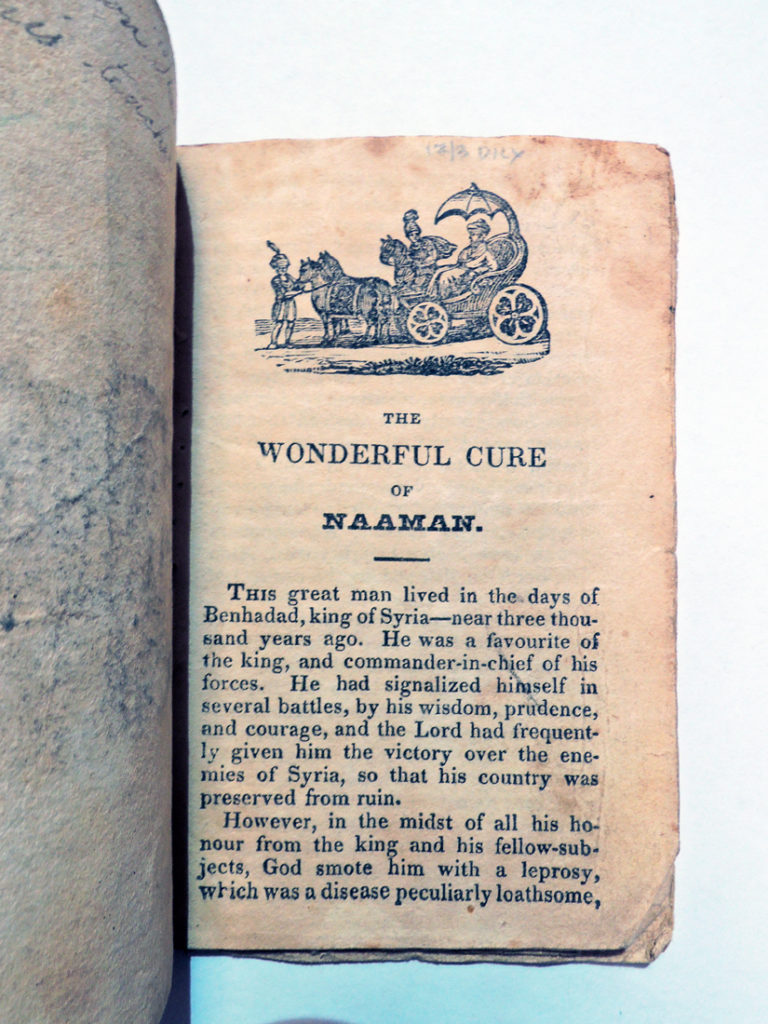 The story of Naaman, a general in the Syrian army whose leprosy is cured by bathing in the Jordan river under instruction of the prophet Elisha, as told by a young slave girl. Price One Penny.
The story of Naaman, a general in the Syrian army whose leprosy is cured by bathing in the Jordan river under instruction of the prophet Elisha, as told by a young slave girl. Price One Penny.
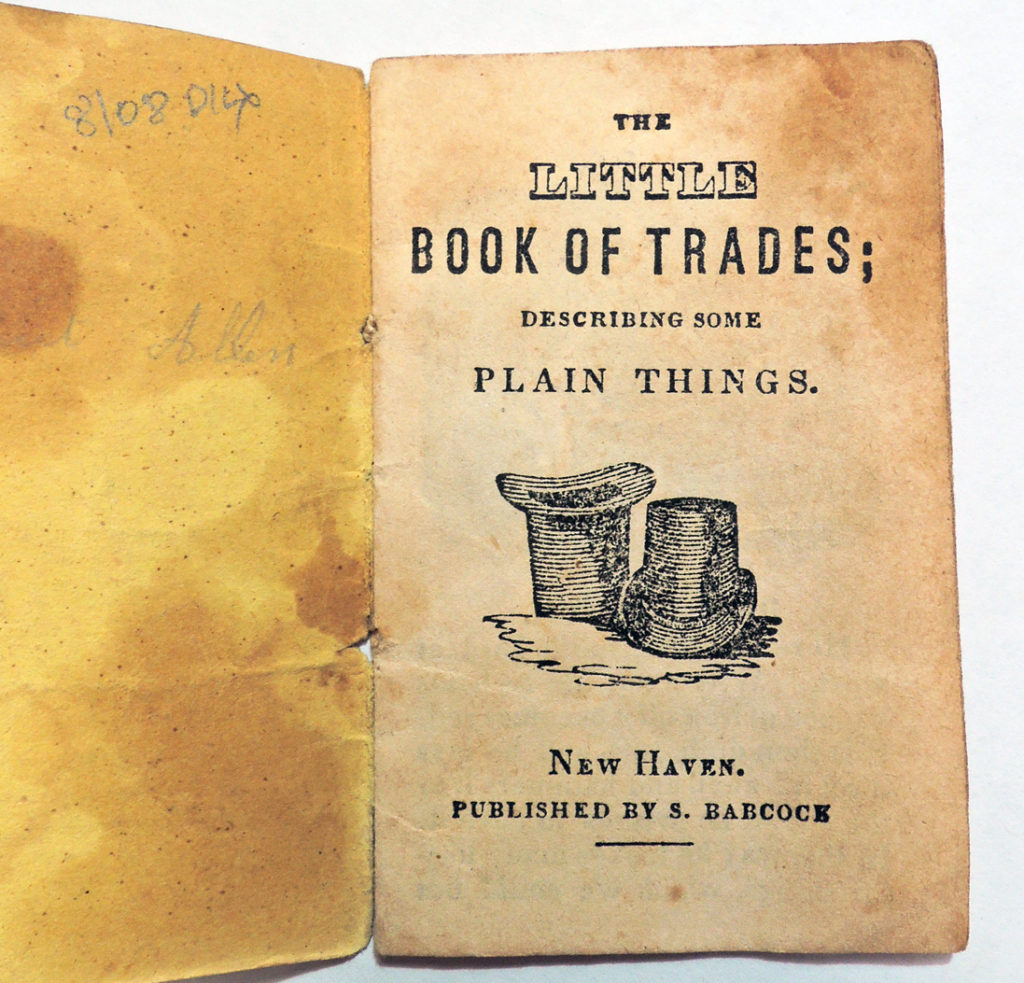 Of the four trades described is the making of paper for books.
Of the four trades described is the making of paper for books.
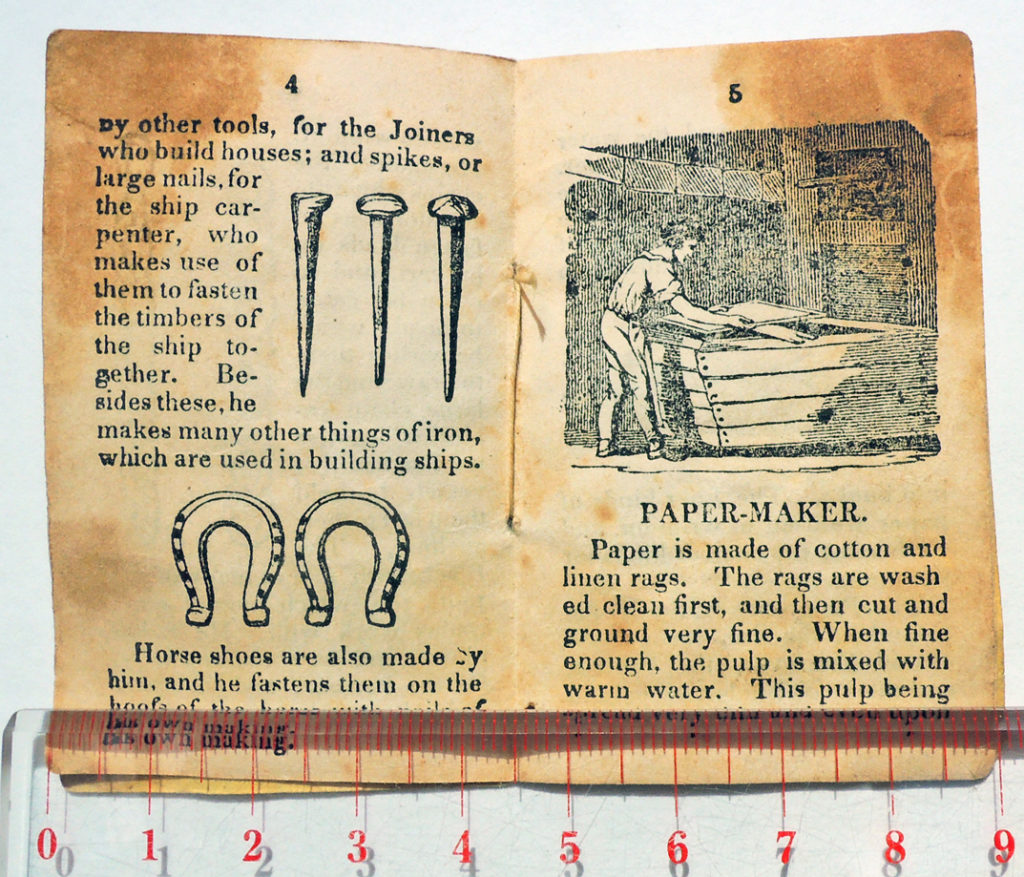
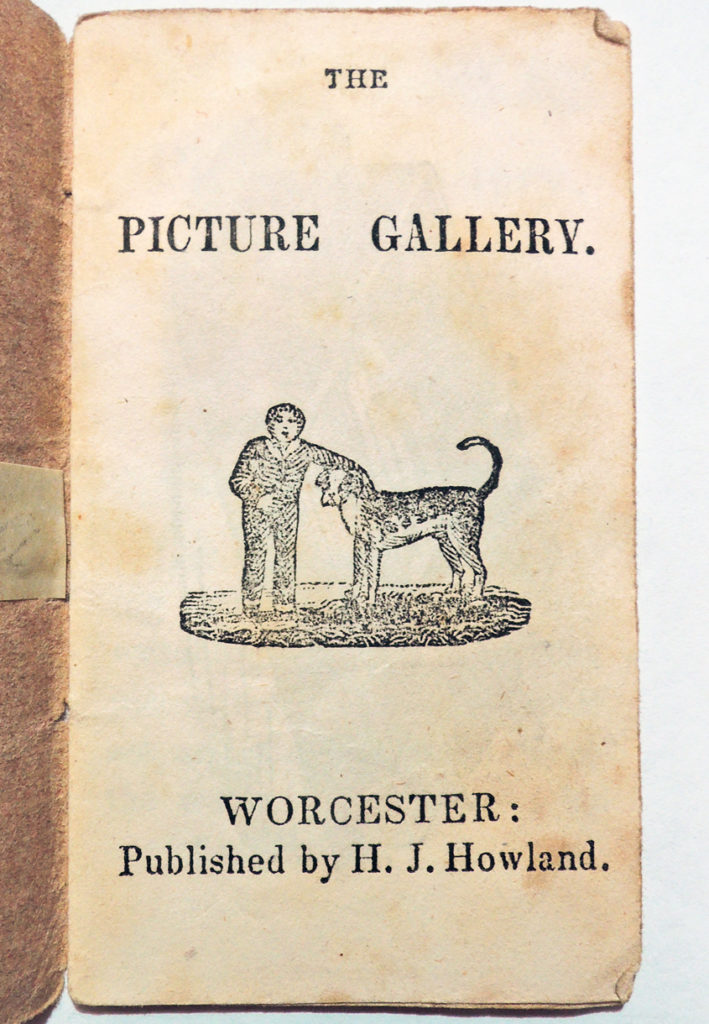 The first picture in the book is not described. What is this?
The first picture in the book is not described. What is this?
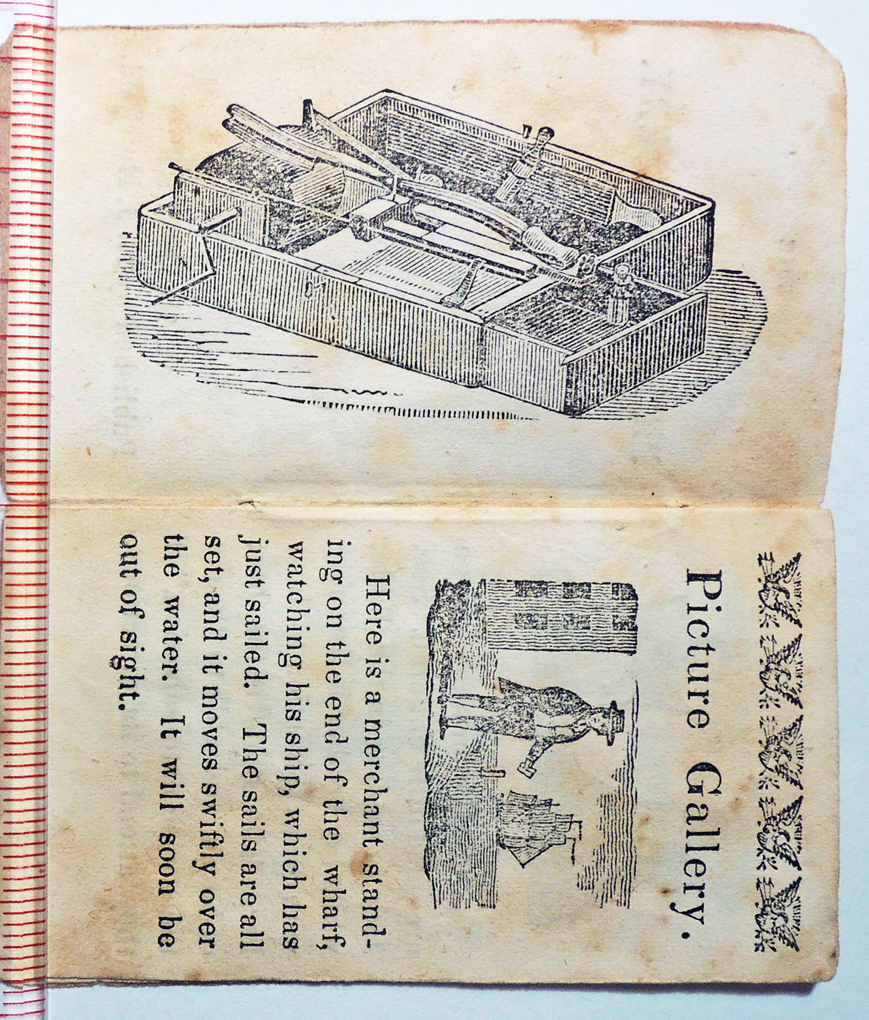 This is a very pessimistic book, see below:
This is a very pessimistic book, see below:

